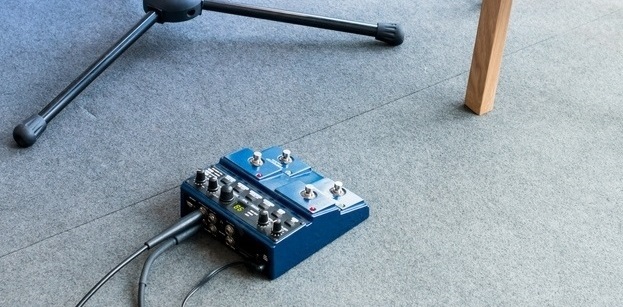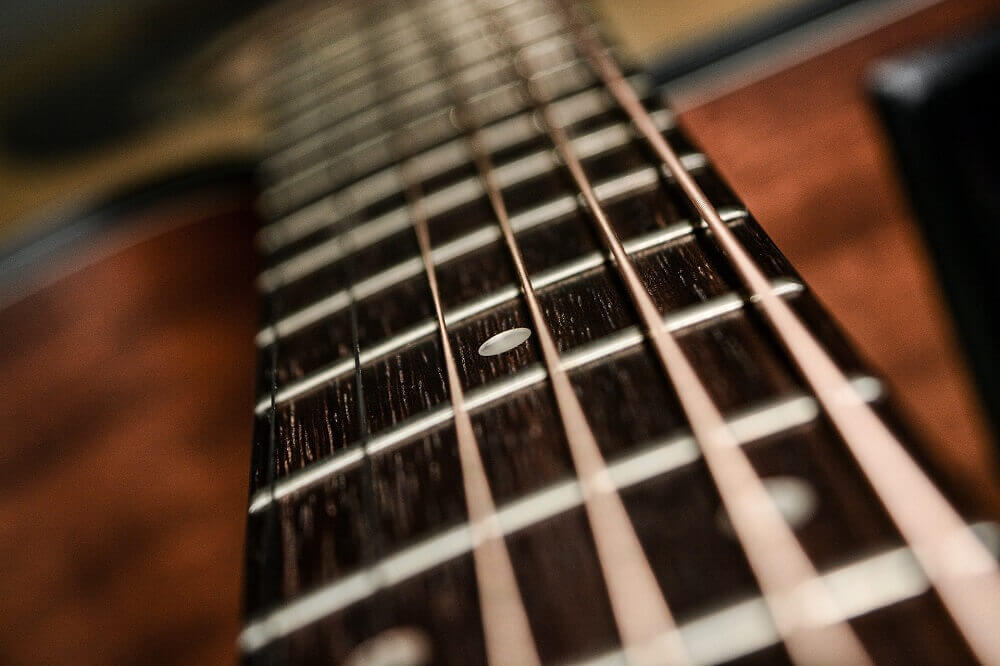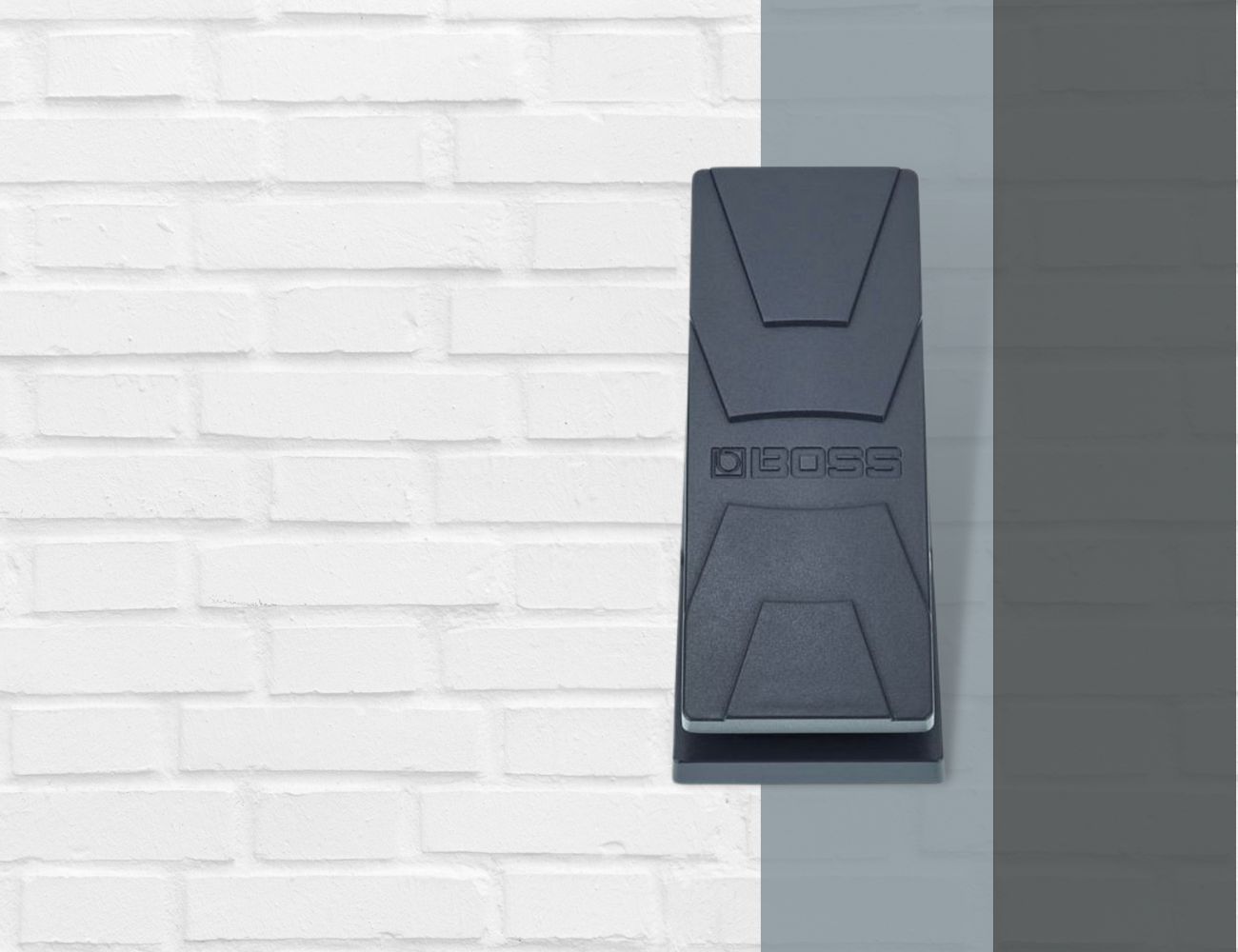Looking to unlock the secrets of mind-bending guitar riffs and musical layers played by yourself?
Chances are, the best looper pedal could be your new best friend.
As every guitarist knows, a high-quality looper pedal can take your performance to another level, offering an array of creative possibilities right under your foot.
But with an overwhelming number of options in the market, choosing the right one can feel like a painful process.
We’ve gone through the noise, researching so you don’t have to and finding those pedals that are worth taking a look.
In this article, we’ll dive into the world of looper pedals, exploring their features, comparing top models, and ultimately guiding you to find the pedal in perfect harmony with your need.
Aside from that, we’ll also take a look at some frequently asked questions on this topic to help you make an informed decision when buying one.
Table of Contents
- Best Looper Pedal
- Boss RC-5 Loop Station Pedal
- NUX Loop Core Deluxe 24-Bit Looper Pedal
- Red Panda Tensor Pedal
- Boss RC-600 Loop Station Looper Pedal
- Digitech TRIOPLUS Looper Pedal
- Donner Circle Looper Pedal
- Headrush Looper Board
- Aeros Loop Studio Pedal With Touch Screen
- TC Electronic DITTO X4 Looper Pedal
- Boss RC-1 Loop Station Pedal
- Line 6 DL4 MKII Delay Modeler With Loop Feature
- Boss RC-500 Loop Station Compact Pedal
- Pigtronix Infinity 3 Deluxe Looper Pedal
- LEKATO Guitar Looper Pedal
- TC Electronic DITTO Looper Pedal
- Boss RC-10R Looper Pedal
- LAMMA FC01 Drum Machine Phrase Loop Pedal
- VSN Twin Looper Electric Guitar Pedal
- BOOMERANG III Guitar Looper Pedal
- Donner Triple Looper Guitar Pedal
- FLAMMA FS21 Drum Machine Looper Pedal
- What exactly is a looper pedal?
- What should you consider when choosing a looper pedal?
- How to properly use a looper pedal?
- – Familiarize yourself with the controls and features:
- – Adjust the parameters to suit your musical goals:
- – Incorporate the loop pedal into your signal chain:
- – Practice starting and stopping the loop with precision:
- – Gradually layer multiple loops to create complex soundscapes:
- – Manage loop volume and balance during live performances:
- – Experiment with different loop textures and effects:
- How to order pedals on a pedalboard?
- Boutique vs. Mass-Produced pedals
- How much should you spend on a guitar pedal?
- Can you use a guitar pedal with a bass guitar?
- How to properly power your pedals?
Best Looper Pedal
Before I begin, here are my top selected choices:
Boss RC-5 Loop Station Pedal

Compact, 32-bit looper with 99 phrase memories, 57 rhythms, MIDI control and 13-hour stereo recording. Check Price
|
|
LEKATO Guitar Looper Pedal

Create and layer captivating loops with extended recording time. Check Price
|
Boss RC-5 Loop Station Pedal
Compact, 32-bit looper with 99 phrase memories, 57 rhythms, MIDI control and 13-hour stereo recording.
The RC-5 offers class-leading sound quality, 99 phrase memories, 57 rhythms, and MIDI control capabilities in a compact looper pedal. It offers 32-bit AD/DA processing and 13 hours of stereo recording time, plus a backlit LCD and multi-function parameter knob for quick access to parameters.
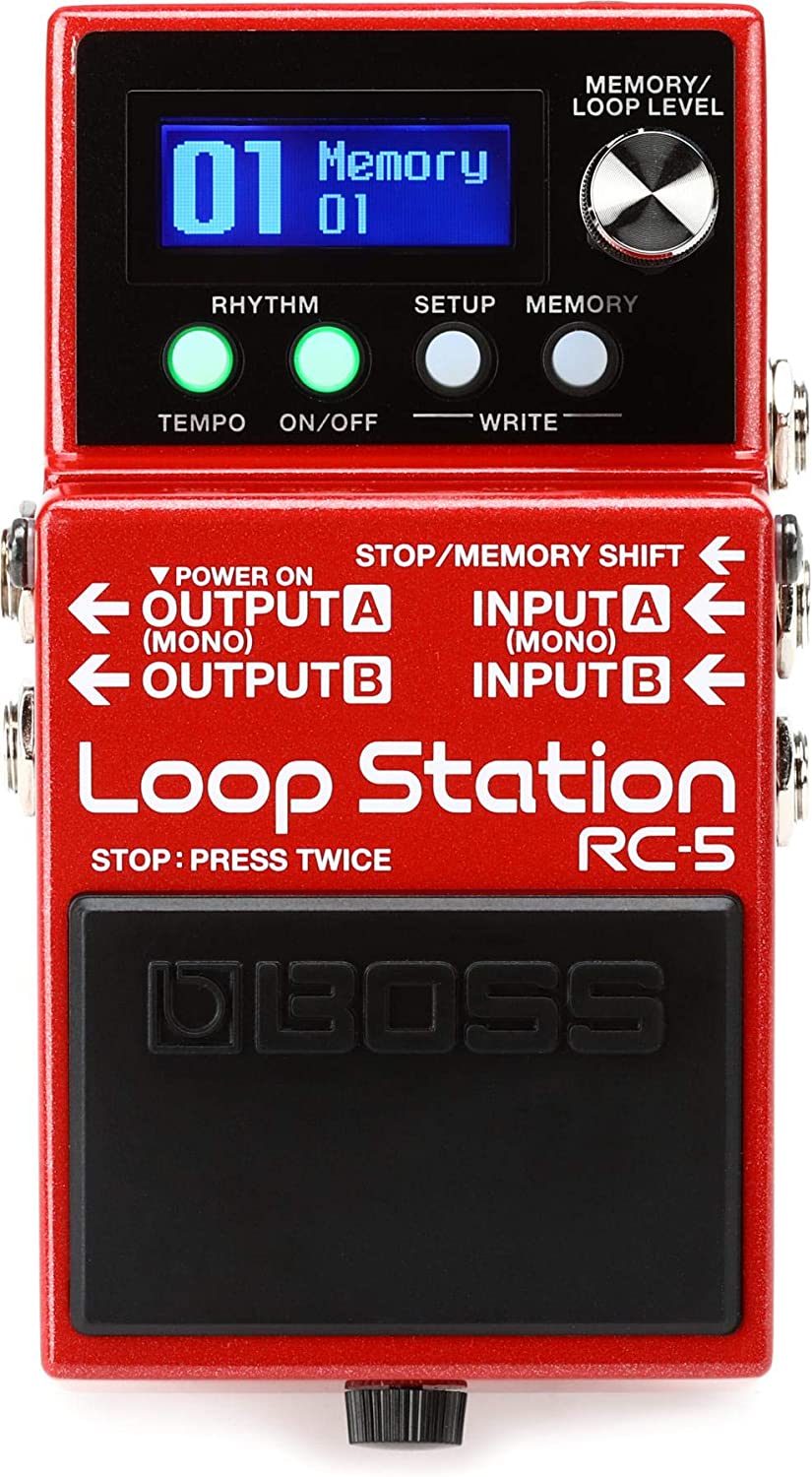
The Boss RC-5 Loop Station is a compact yet highly functional device, this looper pedal is a master at capturing your musical ideas with its exceptional 32-bit sound quality.
Its clear, backlit LCD screen also impresses, making monitoring your loop status a breeze.
With this little powerhouse, you can explore an expansive set of features, including a control jack and TRS MIDI I/O capabilities, expanding your possibilities for control and synchronization.
In addition, the pedal’s robust build comes in two shades – a striking red and classic black, perfect for any setup.
Space is never an issue with the RC-5.
It boasts a massive 13-hour stereo recording capacity, making it a perfect companion for lengthy practice sessions or live performances.
Moreover, it’s packed with over 50 rhythms, opening up a world of beat options.
As if that’s not enough, the RC-5 stores up to 99 phrase memories, giving you quick access to your loops.
Regarding size, the RC-5 doesn’t take up much room on your pedalboard with its dimensions of 6 x 3.75 x 2.65 inches, and it weighs in at just 454 grams.
However, the small size doesn’t detract from its wide array of professional features.
This compact looper is a true powerhouse of musical potential.
- My Review
Stepping into the world of the Boss RC-5 Loop Station is like entering a well-tuned orchestra where I’m both the maestro and the musician.
Upon first glance, the compact size of this pedal might fool you, but let me tell you, it’s a musical titan dressed in a small package.
Plug it in, It feels like unleashing many rhythms, each more compelling than the last.
With over 50 to choose from, I’ve got the power to set the tempo that matches my groove right at my feet.
As a bonus, the backlit LCD screen radiates like a moonlit night, offering a clear overview of the loop status, even in the darkest stages.
Just when I thought it couldn’t get any better, it did!
With this amazing tool, you’ll have an infinite sketchbook to jot down and explore your musical ideas.
Plus, it boasts up to 13 hours of stereo recording time.
Whether a simple acoustic riff or an intricate multi-layered soundscape, the RC-5 captured it in exquisite 32-bit quality.
At the same time, nothing is perfect, right?
I found the absence of a dedicated stop/clear footswitch somewhat of a hiccup.
The alternative is to double-tap the one available footswitch to stop the loop, which can be tricky, especially during a live performance.
If the syncing gear is your thing, the RC-5 stands ready with its TRS MIDI I/O.
Connecting it to other MIDI devices was as effortless as breathing.
One could imagine it like an amicable chameleon, able to adapt and integrate seamlessly into any setup.
Of course, all this functionality is packed into a durable build with a weight of just 454 grams.
But, unfortunately, its compact size made it feel like I was carrying a paperback novel rather than a piece of high-quality music gear.
So there you have it, my honest take on the Boss RC-5 Loop Station.
Here are the ratings I’ll give to the Boss RC-5 Loop Station Pedal:
It’s not just a looper pedal; it’s a creative partner ready to jam when you are.
Despite a few quirks, its versatility and quality make it a powerful addition to any musician’s arsenal.
- Pros:
- Easy to use.
- Premium sound quality.
- Versatile and feature-rich.
- Compact and portable.
- Provides 99 phrase memories.
- Cons:
- Short battery life.
- Learning curve for advanced features.
- Limited documentation/instructions provided.
- No on/off switch.
- Drum patterns need to be memorized.
My final verdict is that the Boss RC-5 Loop Station Compact Phrase Recorder Pedal is a highly versatile and feature-rich looping pedal.
It offers premium sound quality, a compact design, and a wide range of functionalities.
While it may have a short battery life and a learning curve for advanced features, its overall performance and value make it a valuable addition to any musician’s setup.
The positive reviews highlight its capabilities, while the negative reviews point out some areas for improvement.
Considering its brand reputation and the value it provides, the Boss RC-5 Loop Station Compact Phrase Recorder Pedal is a solid choice for musicians seeking a powerful looping solution.
NUX Loop Core Deluxe 24-Bit Looper Pedal
24-bit looper pedal with drum rhythms, frequency compensation, cabinet simulation, and automatic tempo detection.
Loop Core Deluxe Bundle offers convenience and reliability with its pre-installed drum machine and Dual Footswitch, allowing for quick and seamless switching between loop phrases and realistic drum rhythms. It also features frequency compensation for drums, a cabinet simulator, and automatic tempo detection for accurate tones.
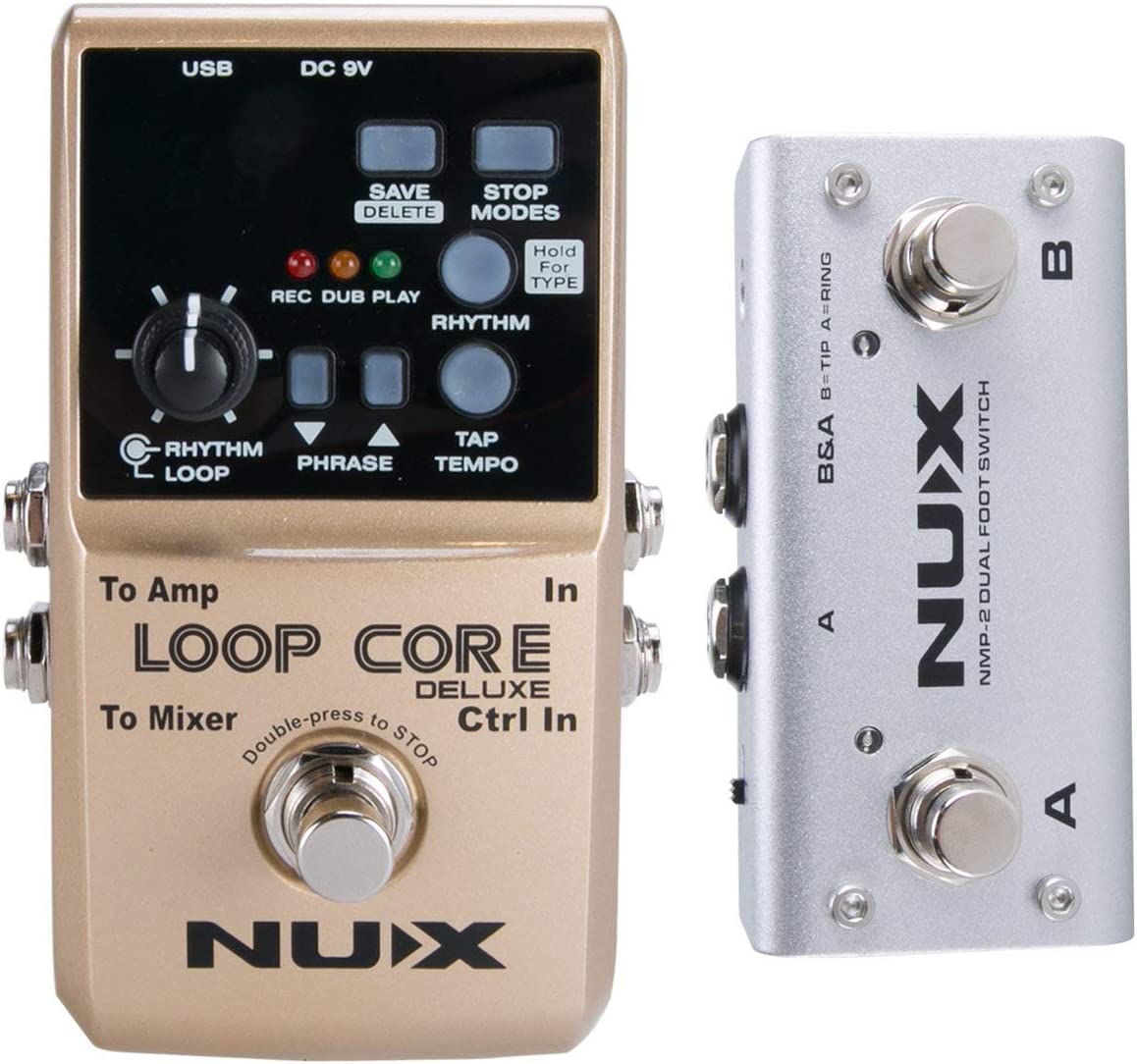
The NUX Loop Core Deluxe is a 24-bit looper pedal for musicians looking to experiment with their craft.
It offers an enhanced level of sound quality with a sample rate of 44.1K and signal processing also at 24-bit.
You can expect clean sound with minimal noise, thanks to its -98dBu noise level.
This pedal also has a special feature — the NMP-2 Dual Footswitch, making swapping between loop phrases effortless.
In addition, musicians will appreciate its built-in drum machine, which boasts 40 different rhythms to suit various genres, from rock to jazz.
Moreover, this pedal has three flexible stop modes, supporting importing and backing up loop phrases.
You can easily manage your loop phrases by connecting them to a PC/Mac via a Mini-B USB connector.
You’ll also find that the Loop Core Deluxe incorporates frequency compensation and cabinet simulation, enhancing your instrument’s drum sounds and overall tone.
Its automatic tempo detection is another valuable feature, allowing you to add a drum pattern that syncs perfectly with your loop.
- My Review
Unboxing the NUX Loop Core Deluxe, I’m immediately struck by its robust build and professional finish.
As I plug my guitar in, the first impressions don’t disappoint.
So here we are, a pedal that feels as impressive as it looks.
I start by experimenting with the looping functionality, and it’s soon clear that this device takes sonic quality seriously.
Every strum and riff, captured in all its 24-bit glory, is played back precisely.
It’s a mirror that doesn’t miss a spot, reflecting every sound detail.
No distortion or noise taints my melody; it’s all crystal clear, the quality that gets approval from even the pickiest musicians.
Fiddling with the NMP-2 Dual Footswitch is a breeze.
With a simple tap, I can switch between loop phrases without missing a beat, adding layers to my performance.
It’s like having a doppelgänger on stage who plays exactly what you’ve just performed – a real-time bandmate of sorts.
The built-in drum machine is like a secret weapon in this musical arsenal.
Having 40 different rhythms at my disposal?
That’s like having an entire percussion section waiting for my cue.
Of course, I’m no drummer, but it lets me lay down a beat whenever inspiration strikes.
The Loop Core Deluxe’s connectivity feature is a boon too.
I can effortlessly transfer my loops to my computer, keeping my creations safe and sound.
Yet, the device isn’t without its quirks.
For instance, navigating through the 40 rhythms can sometimes feel cumbersome.
Also, the automatic tempo detection isn’t always spot-on and might require manual tweaks.
But these are mere blips in an otherwise stellar performance.
The Loop Core Deluxe listens and learns with every note I play, offering a faithful reproduction of my tunes.
Here are the ratings I’ll give to the NUX Loop Core Deluxe 24-Bit Looper Pedal:
It’s like having a reliable jam buddy ready to keep the rhythm while I solo.
In addition, this pedal is a creative companion worth considering for anyone seeking to add new dimensions to their performance.
- Pros:
- Includes drum rhythms for added creativity.
- Allows importing and backing up loop phrases.
- Frequency compensation and cabinet simulation for desired tone.
- Automatic tempo detection for easy loop creation.
- Compatible with 24-bit/44.1kHz WAV files.
- Cons:
- Potential for static noise issue.
- Limited drum presets with cymbal crash at the end.
- Inadequate or confusing instructions/manual.
- Possible connectivity issues with footswitch.
- Some units may arrive defective or not working.
My final verdict is that the NUX Loop Core Deluxe 24-Bit Looper Pedal offers a range of useful features for looping and creative music production.
Its easy-to-use interface, drum rhythms, and frequency compensation provide versatility and enhance the overall tone and performance.
However, it is important to consider potential issues such as static noise, limited drum presets, and connectivity problems reported by some users.
While the brand reputation and customer service response could be improved, the product offers good value for its features.
The NUX Loop Core Deluxe 24-Bit Looper Pedal is a solid choice for musicians seeking a versatile and feature-rich looper pedal.
Red Panda Tensor Pedal
Intelligent, versatile live effects in a compact, pedalboard-friendly design.
The Tensor pedal offers creative time manipulation effects, from live reverse and tape stop functions to intelligent randomization of pitch shifts and phrase slices. It features dual foot switches with both momentary and latching modes, a pedalboard-friendly enclosure, and USB MIDI for recording and sequencing.
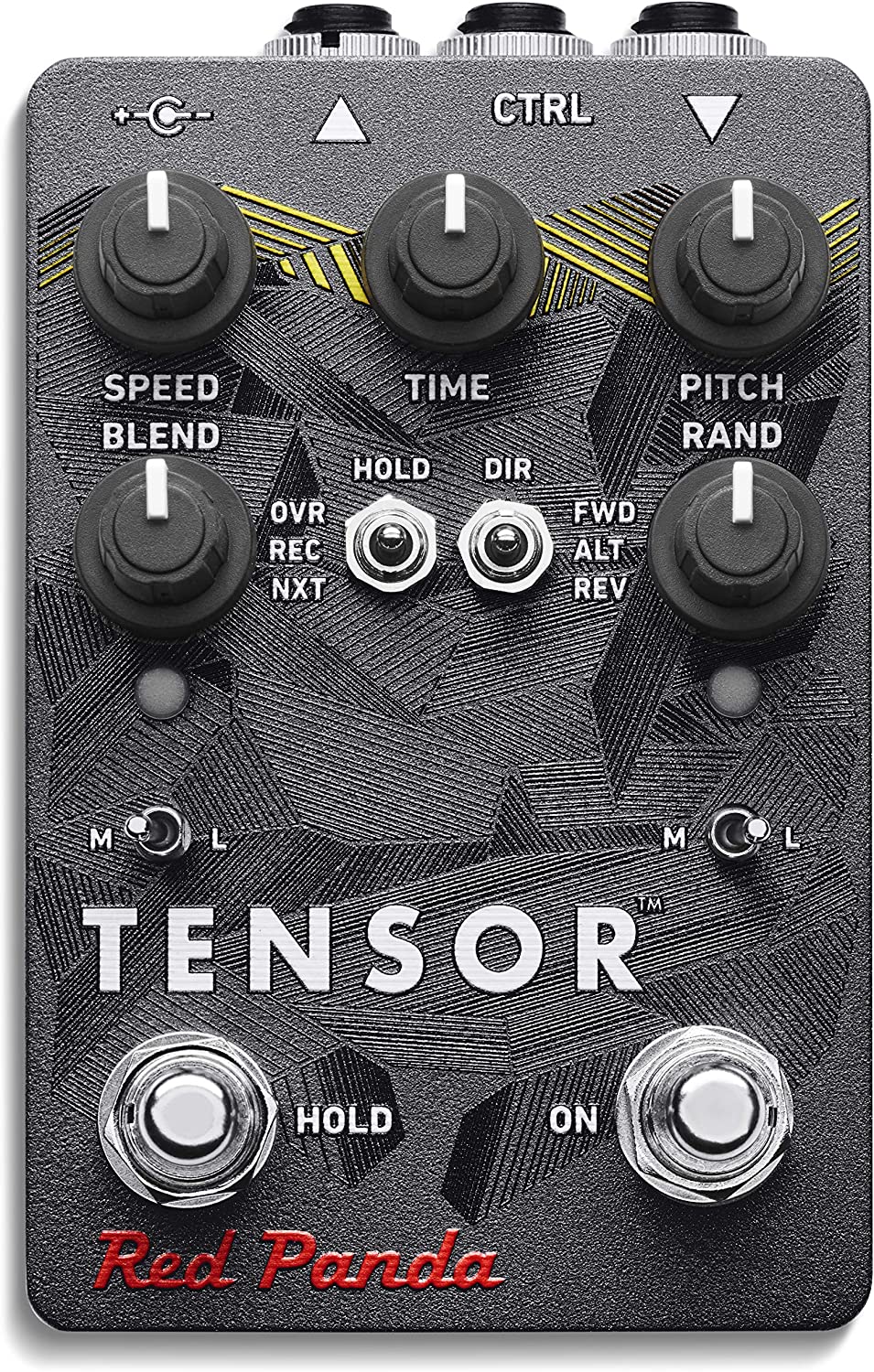
If you’re into adventurous sound experiments, you might want to check out the Red Panda Tensor Pedal.
This handy device takes your music in new directions with its dynamic features.
It’s not just a guitar pedal; it’s a useful tool that mirrors a tape machine or an instrument.
Among its tricks are manipulating the tape speed to move your sound from reverse to stop and forward and a time stretching feature that can be expanded up to four times.
With pitch shifting ranging from -2 to +2 octaves and three different hold modes, this gadget can dramatically alter your music.
It also has an intelligent randomization feature that interacts with the various knob settings.
Designed with a compact style and colored in eye-catching red, this pedal offers versatility in a small package.
It measures 3 x 8 x 10 inches and operates on 9 volts.
Please note that it requires a 9V DC 250 mA power supply, which is not included.
While its strengths certainly lie in its features, the pedal’s physical dimensions and design make it a neat addition to any musician’s gear.
- My Review
Diving headfirst into the world of Red Panda’s Tensor Pedal is like opening the door to a playground of sound manipulation.
With this tool, you’re in command of a sonic spaceship, ready to journey into uncharted music territories.
It’s a compact package packed with power, with its knobs and buttons offering many ways to twist and transform your sound.
Every time I stepped on the Tensor Pedal, it felt like stepping on the gas of a high-powered sports car.
Offering control over the tape speed from reverse to stop to forward, it bends and shapes the sound genuinely mesmerizingly.
Time stretching up to four times offer a realm of possibilities as expansive as they are exciting.
But where this pedal truly sings is in its pitch shifting.
Moving from -2 to +2 octaves was like having a whole choir of tones at my disposal.
It was intriguing to see how the three hold modes interacted with this, allowing for forward, reverse, and alternating directions.
The pedal’s intelligent randomization is no less than a sonic alchemist’s dream come true.
It didn’t merely randomize; it adapted, adding a layer of creativity to every knob setting.
Yet, while the pedal’s randomness can be a delight, it could also be a tad overwhelming, particularly when you’re trying to recreate a specific sound you’ve stumbled upon.
Physically, this pedal scores high.
Compact and dressed in red, it’s a looker on any pedalboard.
The layout is thoughtful, with all jacks on top and well-spaced knobs for tweaking.
Remember to pick up a 9V DC 250 mA power supply since it’s not included in the box.
With the Tensor Pedal at your feet, you’ll stumble upon sounds and effects you didn’t think were possible.
Here are the ratings I’ll give to the Red Panda Tensor Pedal:
It’s an adventure in a box, ready to unfold as soon as you plug it in.
So, buckle up and get ready for the ride!
- Pros:
- Expression pedal compatibility
- Good for experimental and creative use
- Compact and pedalboard-friendly design
- Easy integration with recording and sequencing
- Well-constructed and classy appearance
- Cons:
- Steep learning curve for beginners
- Limited looping time (up to 4.8 seconds)
- Not suitable for standard blues licks
My final verdict is that the Red Panda Tensor Pedal is a highly versatile and feature-rich pedal that offers unique and creative effects.
Its authentic tape sound, compatibility with other instruments, and expression pedal integration open up possibilities for experimentation and sound exploration.
While it may have a learning curve for beginners and a limited looping time, its overall performance, well-constructed design, and positive brand reputation make it a valuable addition to any musician’s arsenal.
Boss RC-600 Loop Station Looper Pedal
RC-600: Next-level looping with customizable, intuitive control.
The RC-600 Loop Station is a powerful floor-based looper from BOSS, loaded with evolved features and customizable functions for guitarists, vocalists, and other musicians. Capture multiple mics/instruments with six stereo tracks and 32-bit sound, and take full command with nine assignable footswitches and external control support. Enjoy an infinite range of creative possibilities with next-level features such as track operations, FX, rhythms, and more.
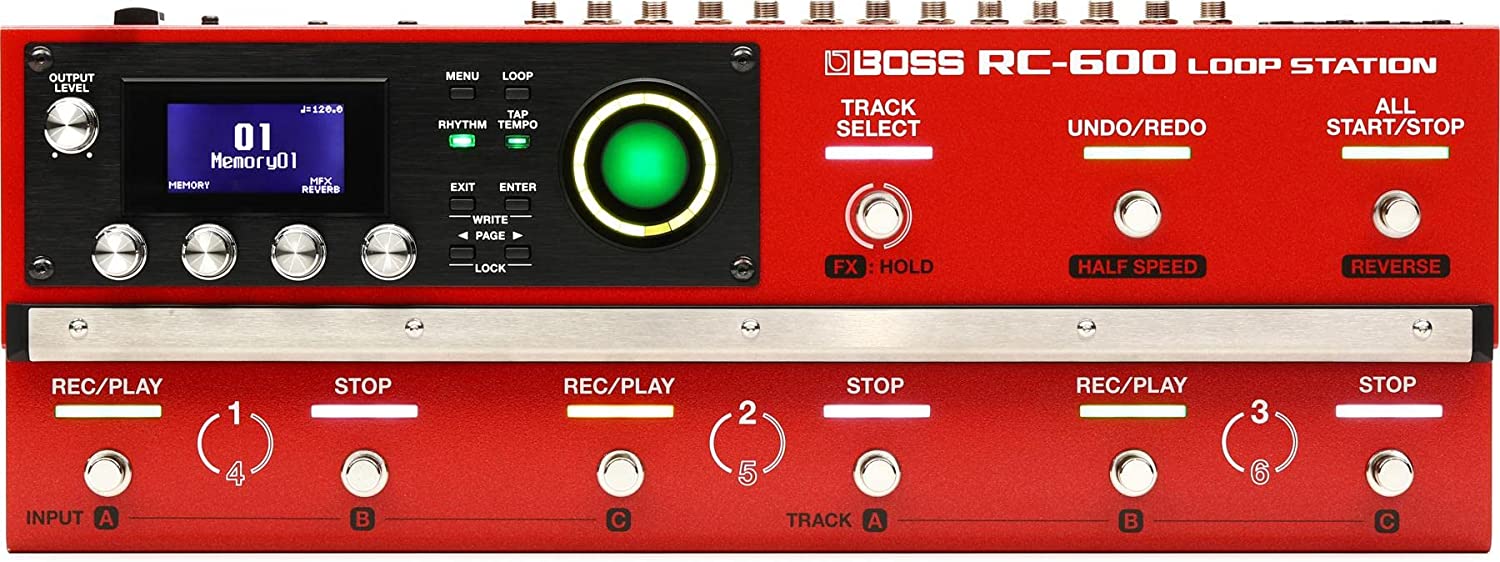
This is the Boss RC-600 Loop Station Looper Pedal, a ground-breaking device that revolutionizes the world of musical looping.
This pedal flaunts six stereo phrase tracks, allowing musicians to capture multiple instruments and vocals with 32-bit sound quality.
Versatility is at its peak, as it comes with 2 XLR microphone inputs that feature phantom power, along with two stereo pairs for instrument or line inputs.
Musicians will also appreciate its massive storage capacity, holding 99 phrase memory presets.
It’s more than just a looping station; it also serves as a rhythm guide.
Moreover, its robust construction and dimensional specifics, measuring 22.88 x 9.81 x 4.88 inches and weighing 8.2 pounds, make it easy to accommodate within your setup.
This pedal operates on a 9-volt power supply and is a creation of BOSS, a brand widely acclaimed for its high-quality musical equipment.
- My Review
Having had the pleasure to delve into the world of sound with the Boss RC-600 Loop Station Looper Pedal, I can attest to its remarkable prowess in capturing and reinterpreting music.
Six stereo phrase tracks are at your fingertips, a feature that feels like a symphony waiting to unfold from your instrument.
It allows you to paint your musical masterpieces like a canvas with ample space.
But let’s talk about sound quality; it’s like the clear, crisp air on a mountaintop.
It’s that pure, thanks to the 32-bit sound quality.
And it doesn’t matter if you’re a vocalist or an instrumentalist; two XLR microphone inputs and two stereo pairs for instrument or line inputs mean everyone’s invited to this sonic party.
Storing and retrieving your crafted loops is a breeze too.
With 99 phrase memory presets, it’s like having a vast library where each book sings a tune of your creation.
In the silence between your notes, it’s not just a looping station but a rhythm guide, a metronome beating the rhythm of your artistry.
Built like a tank, its robust construction would weather any storm and fit snugly into your gear setup.
It’s not feather-light at 8.2 pounds, but it’s a bearable weight, a small price for the wealth of features it brings.
And it draws power from a 9-volt supply, an energy-efficient powerhouse.
The initial learning curve would be if I had a bone to pick.
But as they say, “Rome wasn’t built in a day.” So with patience and practice, you’ll be orchestrating looped symphonies in no time.
Here are the ratings I’ll give to the Boss RC-600 Loop Station Looper Pedal:
This pedal is the epitome of what BOSS represents – a confluence of superior technology and musicianship.
But it’s not just a device; it’s a ticket to a musical journey, one loop at a time.
- Pros:
- Extremely configurable and powerful
- High-quality sound and audio engine
- Multiple input options for mics and instruments
- Customizable footswitches and pedal modes
- Cons:
- Some users reported software bugs and crashes
- Learning curve and complex configuration
- Possible issues with button durability
My final verdict is that the Boss RC-600 Loop Station Looper Pedal is a highly versatile and feature-rich device with excellent tone and performance.
Despite some reported software bugs and a learning curve, its customizable footswitches and deep control options make it a powerful tool for creative musicians.
The brand reputation of BOSS adds to its appeal.
Overall, considering its value and the positive reviews, the RC-600 is a recommended choice for looping musicians.
Digitech TRIOPLUS Looper Pedal
Easy-to-use guitar pedal creates personal band with loops and 12 music genres.
The DigiTech TRIO+ pedal listens to your guitar playing and creates a virtual band, with adjustable bass and drum parts. Loop, sequence and store up to 12 songs on the Micro SD card for easy playback.
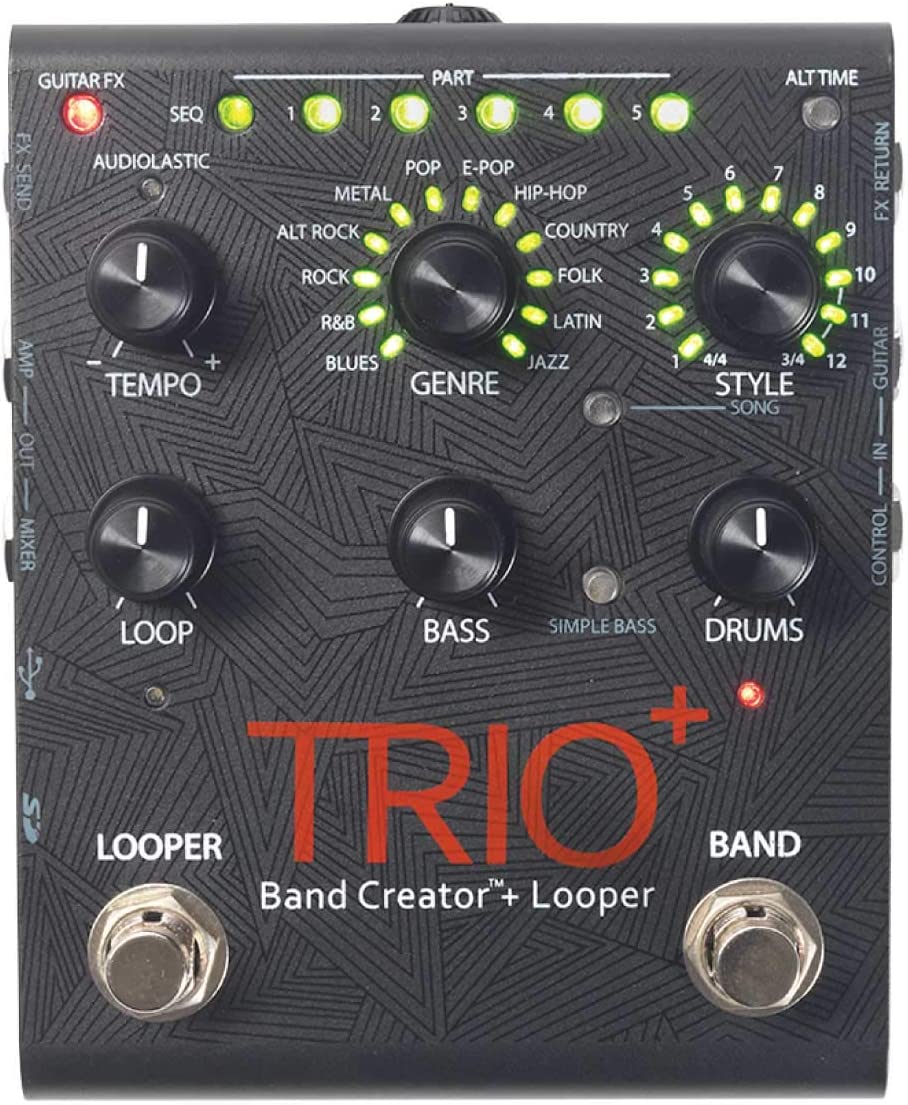
Let’s chat about the Digitech TRIOPLUS Looper Pedal, an incredible companion for any solo artist.
It’s no ordinary effects pedal; it can “listen” to the chords and rhythm you play and automatically generate bass and drum parts that match your song.
Just think about it: you’re practicing, and it feels like you have a personal band in the room.
And get this – it has a built-in looper!
You can lay down synced guitar loops to jam over or record multi-part songs without needing external gear.
There are multiple genres and styles for those who want to fine-tune the sound.
It’s pretty compact and easy to fit in most gig bags.
Plus, there’s a convenient headphone jack for those late-night practice sessions.
Truly, this little gadget could give your music-making a fresh spin.
- My Review
Stepping into my personal jam space, there’s a game-changer on the floor – the Digitech TRIOPLUS Looper Pedal.
It’s like having a band in a box that doesn’t talk back.
I’m immediately struck by its innovative design – robust and streamlined.
It doesn’t just look the part; it lives up to it, like a reliable old friend, always ready to help you nail that solo.
Plugging in my guitar and getting started is as easy as a Sunday morning.
I play chords, tap the footswitch, and voilà, jamming with a virtual bassist and drummer.
It’s pretty cool how it interprets my rhythm and chord progressions.
But let’s face it, it’s not psychic – sometimes, it doesn’t quite catch my vibe. Yet, for the most part, it’s like it’s reading my musical mind.
Having a built-in looper feels like a cherry on top.
It enables me to layer my guitar parts and create intricate soundscapes. It’s a treat for any loop enthusiast.
However, I can’t help but notice the absence of an undo function.
There have been moments where one wrong loop could send everything south, and I wish I could undo it.
Different genres and styles? Check.
A headphone jack for silent practice? Check.
A compact size that fits in my gig bag? Check.
This pedal has features but doesn’t compromise simplicity and ease of use.
Let me be real, though – the Digitech TRIOPLUS Looper Pedal isn’t flawless.
There are a few misses here and there, like the lack of an undo function for the looper.
Here are the ratings I’ll give to the Digitech TRIOPLUS Looper Pedal:
However, the pedal has become my routine, even with these minor hiccups.
It doesn’t just offer features; it brings an experience, a sense of having a personal band at your command, and that’s a powerful thing for me.
- Pros:
- Easy-to-use guitar pedal.
- Automatically generates bass and drum parts.
- Offers adjustable tempo and time interpretation.
- Provides looping feature.
- Cons:
- Bass and drum levels may need adjustment.
- Drum sounds may not meet professional standards.
- Song parts and editing can be challenging.
My final verdict is that the Digitech TRIO PLUS Band Creator and Looper is a versatile guitar pedal with many useful features.
While it may require adjustments for bass and drum levels, and the drum sounds may not meet professional standards, it offers a convenient and easy-to-use solution for generating bass and drum parts.
In addition, its looping feature, adjustable tempo, and various music genres add to its appeal.
Considering its performance, brand reputation, and value, I recommend the Digitech TRIO PLUS for guitarists looking to enhance their practice sessions and create dynamic accompaniments.
Donner Circle Looper Pedal
Upgrade your sound with 160 mins looping, 100 drum grooves, and USB import/export.
The Circle Looper is a stereo looper guitar pedal with 100 different drum grooves, an import/export function, and an editor software for complete control. It features a looper control with adjustable position, volume level, and fade-out time, as well as a rhythm control with adjustable type, speed, and volume level. The pedal also has a merger control to toggle between Looper and drum machine, and two footswitches for easy operation. The perfect tool for guitarists looking to add more sound to their performances.
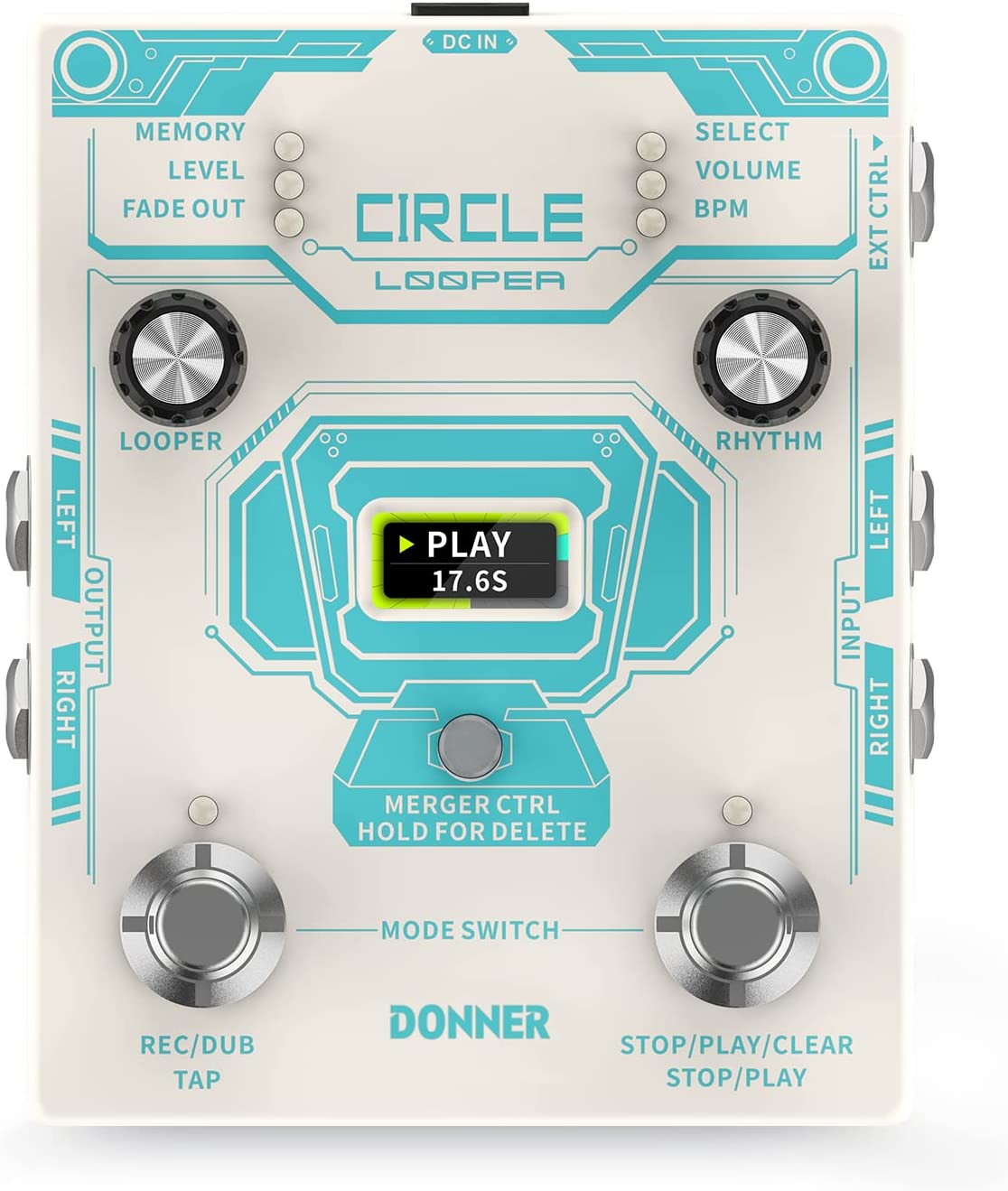
The Donner Circle Looper Pedal, bathed in a sleek white color, is a versatile tool for any guitarist, offering a dual-functionality as a looper and drum machine.
With this petite device measuring roughly 5.12 x 4.72 x 2.56 inches, you get a powerful 24-bit, 44.1kHz stereo looper capable of playing 100 unique drum grooves across ten music styles.
Offering a generous storage capacity, you have 40 slots to fill with up to four minutes of recorded audio each, which it dutifully keeps safe, even when powered down.
A standout feature is its brightly-lit screen, offering real-time insights into your loop’s timing and progress.
This pedal’s exciting capability is its ability to import and export your creations through a USB connection, facilitated by Donner’s editor software.
Additional functions, such as tap tempo and fade out, make it an even more versatile tool, and it’s also ready to work with an external footswitch, though that’s sold separately.
- My Review
Unwrapping the Donner Circle Looper Pedal, I couldn’t help but notice its clean white aesthetic, solidly constructed and promising a world of musical exploration.
Fitting snugly in hand, it doesn’t consume much real estate on your pedalboard yet packs a hefty punch with its capabilities.
Plugging in, the crisp 24-bit, 44.1kHz audio fidelity was music to my ears.
I was immediately drawn to the smorgasbord of 100 drum grooves spread across ten music styles.
But that’s just the start.
Recording a loop, I found the pedal’s large capacity inviting; 40 slots, each storing four minutes of audio, equates to some serious jamming potential.
Noteworthy was the nifty screen that proved an ally in my sonic sojourns, constantly updating me on my loop’s progress.
With its help, I navigated the waters of loop creation effortlessly, fully immersed in the moment.
It’s a cool feature that keeps you in the driver’s seat.
One bit that had me grinning was the USB import/export functionality.
It opened up a new realm of possibilities, allowing me to export my creations, tweak them in the included software, or share them with friends.
This pedal seemed determined to become my new best musical friend.
But no product is perfect, and the Donner Circle Looper Pedal is no exception.
For example, it didn’t come with a power adapter – an omission that felt akin to selling a car without tires.
And while I eventually groaned the workings of the pedal, a novice guitarist might find the instant recording start upon pressing the button a bit disconcerting.
Here are the ratings I’ll give to the Donner Circle Looper Pedal:
Despite these peculiarities, I can confidently say the pedal has much going for it.
Its potential to act as a springboard for creativity is immense, and for those willing to venture beyond the initial bumps, it’s a worthy companion on their musical journey.
- Pros:
- Compact size and easy to use.
- High-quality stereo looper and drum machine.
- Large memory capacity for storing recordings.
- Supports import/export via USB with editor software.
- Cons:
- Power adapter not included.
- Possible software issues for some users.
- Potential tone loss with buffered output.
- Timing glitches and delay when stopping/starting loops.
My final verdict is that the Donner Circle Looper Pedal is a versatile and feature-rich option for guitarists.
It offers a high-quality stereo looper and drum machine with a large memory capacity for storing recordings.
The import/export function adds convenience for users.
However, there are potential drawbacks, such as the lack of a power adapter, possible software issues, and the potential for tone loss with the buffered output.
Nevertheless, considering the overall positive feedback and value for the price, the Donner Circle Looper Pedal is a solid choice for musicians seeking a compact and affordable looping solution.
Headrush Looper Board
Create, transform and customize infinite loops with premium FX, intuitive touch interface, and flexible audio routing.
Headrush Looperboard is a powerful and intuitive standalone looper pedal with a 7-inch touch display, offering up to 8 hours of recording time, 12 footswitches, customizable workflow, premium FX, and flexible audio routing. It lets you create, transform and optimize your perfect loop to give your performance a professional edge.
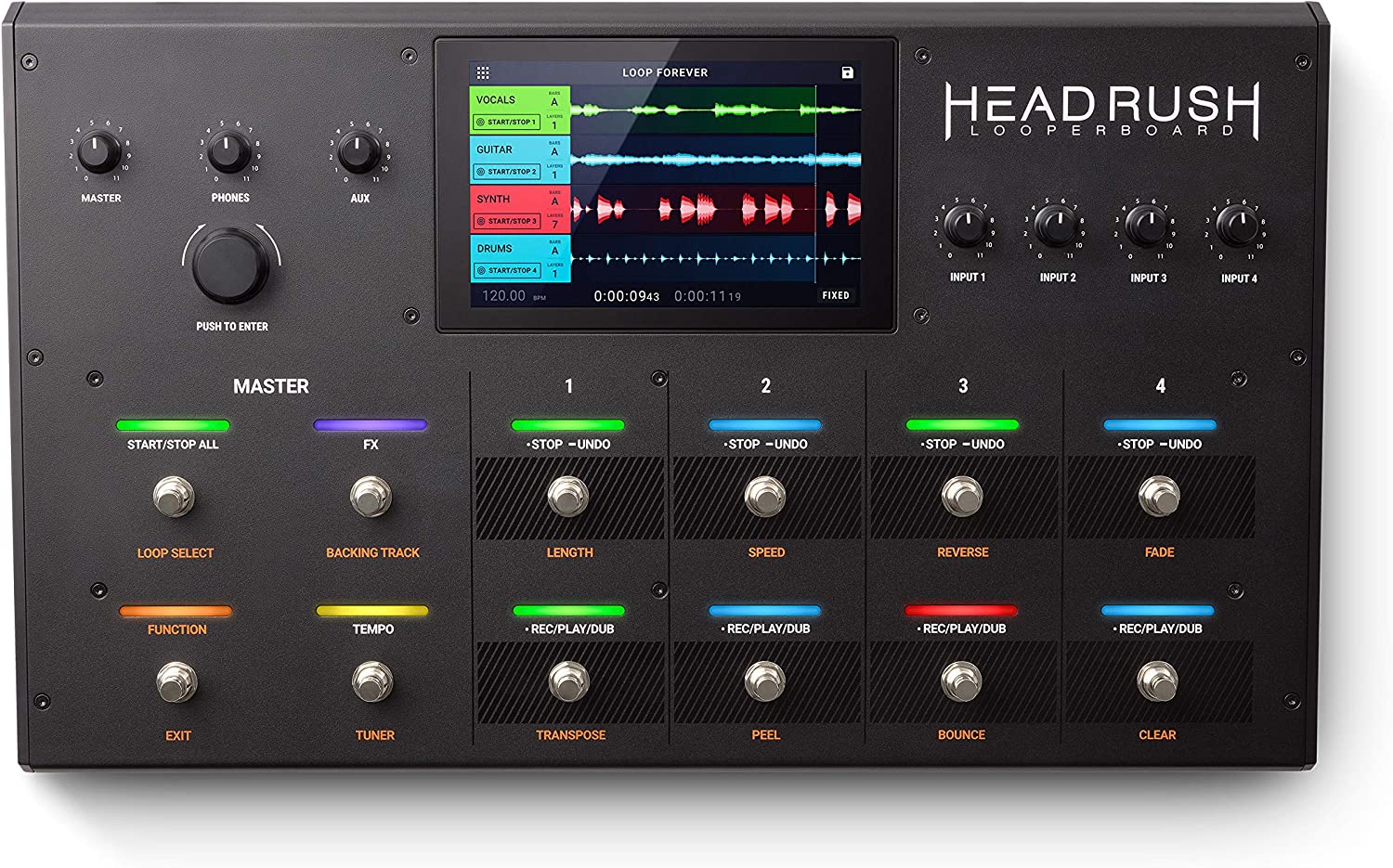
Stepping into music and creativity, you’ll find the Headrush Looperboard, a standalone looper that stands out.
Imagine having a seven-inch high-resolution display that responds to your touch, giving you an intuitive and interactive experience to create musical masterpieces.
In addition, this sturdily built gadget boasts a steel chassis designed for the rigors of the road.
Its defining feature? A dozen footswitches are embedded and armed with RGB LEDs for easy visual feedback.
These aren’t just switches; they’re your key to creating and transforming loops in real-time.
It also has built-in effects to accompany your instruments, perfect for adding more spice to your performance.
Making connections won’t be a hassle, either.
The Looperboard houses four combo XLR+ ¼ -inch inputs, dedicated controls, and switchable +48V phantom power.
Add four assignable XLR, ¼ -inch outputs, and headphone outputs for all your audio needs.
Furthermore, storage won’t be a concern with over eight hours of internal recording time, over 300 built-in loops included, and inputs for SD and USB storage.
Finally, studio-grade capturing at up to 24-bit/96kHz quality means your creativity won’t be compromised.
It’s not just a looper; it’s your companion in crafting the perfect musical experience.
- My Review
Let me tell you, I’ve had the opportunity to test out the Headrush LOOPERBOARD, and this piece of equipment packs a powerful punch for looping enthusiasts.
As someone who prides themselves on finding the best gear in the market, I was eager to try it out.
Walking up to this marvel, you can’t help but notice the massive 7″ high-resolution display that serves as the main user interface for a rich selection of features.
It truly provides a creative treasure trove, with its ability to effortlessly control audio looping, effects, and smart touch operations.
Speaking of effects, step aside the wizarding world – the Headrush LOOPERBOARD is about to cast a spell on your music.
It comes equipped with easily customizable, high-quality onboard effects to enhance your instrument to a whole new level.
Moreover, navigating the interface is a piece of cake, making customizing your settings as smooth as gliding through the clouds.
I appreciated the ample storage capacity during my time with the Headrush LOOPERBOARD.
The internal memory, SD card slot, and USB input felt like an infinite musical playground.
Now, onto some darker clouds hovering above this otherwise beautiful horizon.
Undoubtedly, its substantial size might not be everyone’s cup of tea.
But, add its bulky dimensions to its rather intimidating price tag, and we’ve summoned some potential budget-friendly and space-saving challenges.
Despite my overall positive experience, it pains me like a kick to the shin to inform you about a few heart-wrenching issues some might face.
Between construction flaws, odd crashes, and regrettable customer support, the Headrush LOOPERBOARD may demand a leap of faith with its purchase.
Nonetheless, my firsthand experience with the Headrush LOOPERBOARD left me impressed and feeling accomplished.
Here are the ratings I’ll give to the Headrush Looper Board:
So if you value functionality, innovation, and features that can turn any solo performance into a captivating experience, consider giving this gear a fair chance.
Just keep in mind those caveats – sometimes, greatness comes at a cost.
- Pros:
- Intuitive touchscreen interface
- Versatile and customizable workflow
- Extensive storage capacity
- Premium effects for various instruments
- Cons:
- Usability issues reported by some users
- Potential crashing and bugs
- Inconsistent footswitch performance
- Limited customer support and replacement parts
My final verdict is that the Headrush Looperboard is a feature-rich and versatile looper with an intuitive touchscreen interface and premium effects.
However, it has some reported issues with usability, potential crashing, and inconsistent footswitch performance.
The brand’s customer support and availability of replacement parts are also areas of concern.
Considering all factors, it can still be a valuable tool for musicians seeking advanced looping capabilities, but potential buyers should be aware of the reported drawbacks.
Aeros Loop Studio Pedal With Touch Screen
6 tracks, intuitive touchscreen, hands-free mixing.
Aeros Loop Studio is the ultimate looper pedal with 24-bit sound, up to 36 loops per song, and hands-free mixing mode. Create, record, and perform with its touchscreen display, color-coded waveforms, and master volume control.
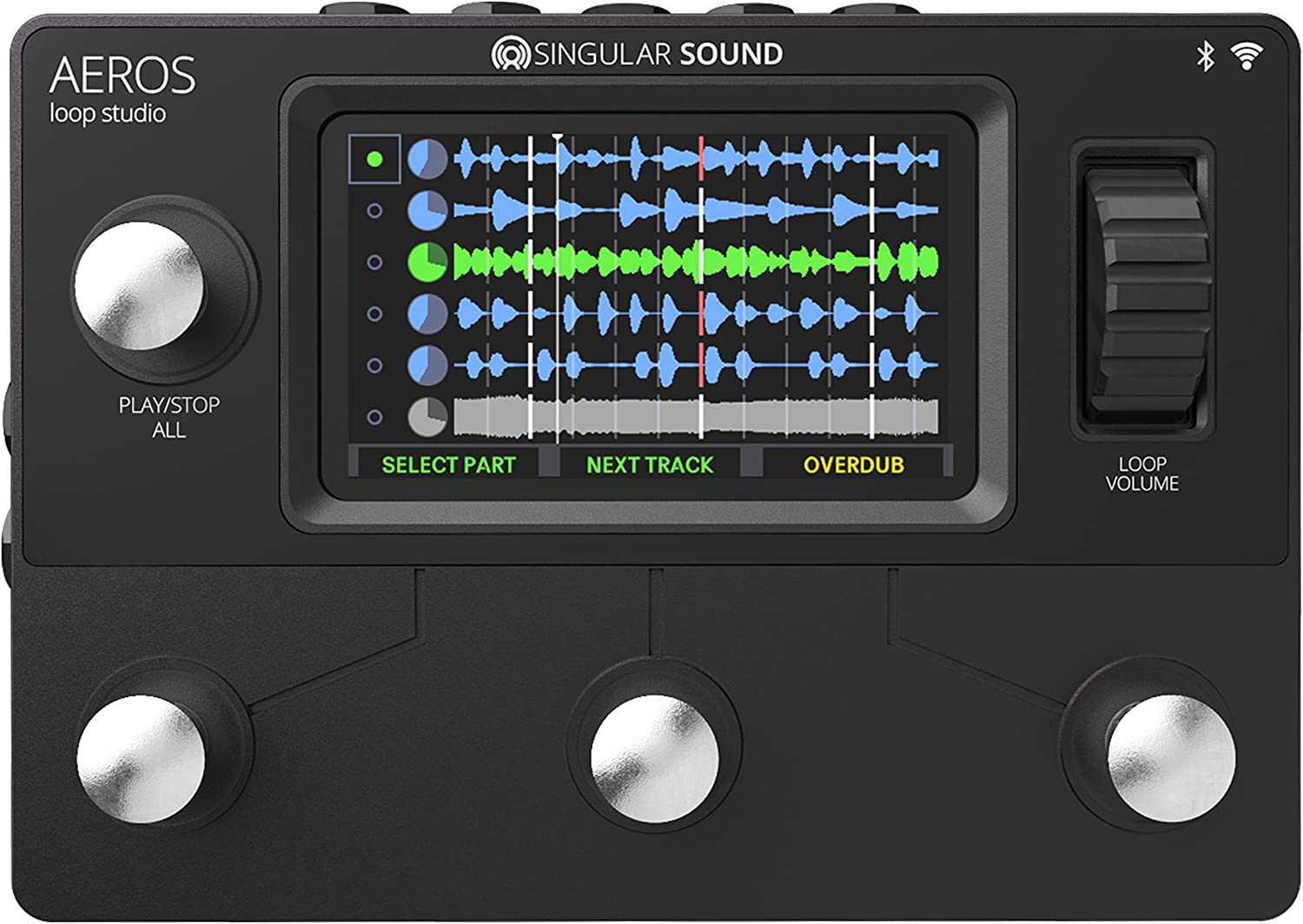
Aeros Loop Studio is a top-notch looper pedal designed specifically to cater to the needs of guitarists, bassists, vocalists, and other musicians.
With the ability to create studio-quality, 24-bit recordings, this powerful pedal offers a touchscreen display and color-coded waveforms that streamline the looping process.
The Aeros Loop Studio allows for endless creative experimentation through unlimited overdubs by offering up to 6 parallel and sequential tracks for a maximum of 36 unique loops per song.
One standout feature is the built-in hands-free mixing mode, which enables users to adjust individual track volumes while performing or tweak their master volume with the pedal’s ergonomic scroll wheel.
Moreover, it is equipped with multiple inputs and outputs with various routing options, making it effortlessly compatible with up to three instruments at a time.
Loops can be saved to internal storage or an SD card (which is not included) and later exported for use in digital audio workstations.
Designed by a dedicated team in Miami, Florida, the Aeros Loop Studio is crafted to endure the most intensive tours or performances on any stage.
- My Review
Having had the opportunity to explore the Aeros Loop Studio, I have to say that it truly stands out as an impressive and versatile looper pedal.
First and foremost, the sound quality is phenomenal — recording and playback deliver crystal-clear 24-bit audio that is genuinely on par with studio-grade recordings.
One of my favorite aspects of the Aeros is its incredibly user-friendly interface.
With its touchscreen display, navigating different functions and adjusting settings is an absolute breeze.
Plus, the color-coded waveforms are a game-changer, making the looping process visually intuitive and easy to follow.
Gone are the days of getting lost while looping madness!
Working with this pedal felt like I had complete control over my music.
It offers up to six parallel and sequential tracks, permitting 36 unique loops per song.
And, with its hands-free mixing capabilities, I found it delightfully simple to alter individual track volumes and the master volume on the go.
While the Aeros Loop Studio is undoubtedly packed with exceptional features, it does have a few drawbacks, one being the headphones issue.
As I often practice with headphones, it would be nice not to require a separate preamp.
Another challenge I faced was the limited number of buttons, which occasionally hindered efficiency during use.
Here are the ratings I’ll give to the Aeros Loop Studio Pedal With Touch Screen:
Despite these minor drawbacks, I could not deny the device’s durability and quality.
It feels like the Aeros Loop Studio was meticulously designed to withstand the wear and tear of concerts and tours, demonstrating that it was built to last.
- Pros:
- Intuitive interface with color-coded waveforms.
- Ability to record and play 6 tracks per song.
- Built-in Mixer View for live control and mixing.
- Up to 10 hours of recording time per song.
- Cons:
- Requires a preamp for headphone use.
- Limited number of buttons for efficient usage.
- Section limitations for longer loop runs.
- No support for importing MP3 backing tracks.
My final verdict is that the Aeros Loop Studio looper pedal offers musicians a highly versatile and feature-rich experience.
Its intuitive interface, color-coded waveforms, and ability to record and play six tracks per song provide ample creative potential.
In addition, the built-in Mixer View adds live control and mixing capabilities, enhancing the performance experience.
However, it’s important to note that headphone use requires a separate preamp, and there are some limitations, such as the number of buttons and section length.
Nevertheless, considering its strong performance, reputable brand, and reasonable value, the Aeros Loop Studio looper pedal is a solid choice for musicians seeking a reliable and powerful looper pedal.
TC Electronic DITTO X4 Looper Pedal
Creative dual-track looper with seven loop FX and MIDI sync.
DITTO X4 LOOPER is a dual-track guitar looper with 7 loop effects, loop decay and MIDI sync, enabling guitarists to create stunning, multi-layered compositions with ease. Its intuitive design and powerful features make it an ideal tool for crafting unique sonic masterpieces.
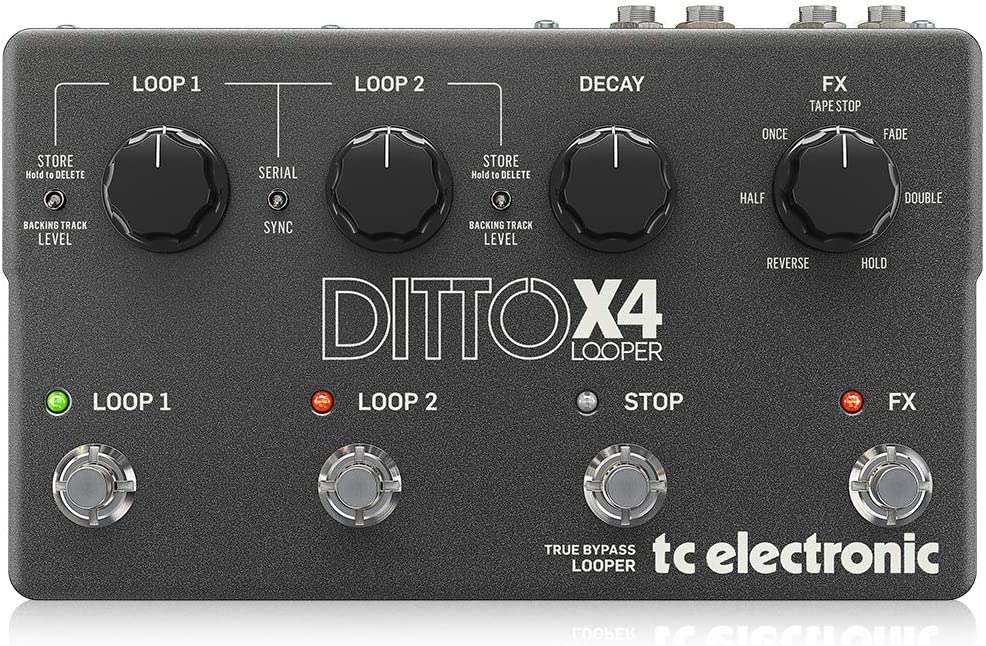
The TC Electronic’s DITTO X4 Looper Pedal is a real game changer in the music industry.
With its compact design, it fits snugly into any musician’s gear.
In addition, this little powerhouse has two independent looping channels, offering plenty of space to lay down your tracks.
You can even play these loops simultaneously or sequentially, talk about versatility!
Decay control is another impressive feature, letting you control how quickly previous loops fade out.
Not just that, it’s brimming with seven loop effects, including half-speed and reverse – adding just the right amount of spice to your tunes.
Musicians will appreciate the simplicity of its design – with just a few knobs and switches, you’re ready to create magic.
Don’t worry about synchronization; the DITTO X4 has a MIDI sync option, ensuring your loops stay on beat.
Thanks to its USB port, there’s also an option to store and retrieve loops.
Quite a tool for those looking to explore the realm of looping.
- My Review
Diving into the realm of looping with the DITTO X4 Looper Pedal was a thrilling and educational journey.
It felt like a small orchestra under my feet, yet it was so compact and unassuming on my pedalboard.
Nevertheless, it’s a wizard of a tool that turns a single musician into a full ensemble with just a few foot taps.
I was playing with the two independent looping channels and felt like having a musical partner at my feet.
It was akin to a dance, weaving in and out of layers of sound with just a nudge of my foot.
The ease of switching between simultaneous and sequential loops gave me so much room to experiment, like a chef tossing ingredients into a pot, concocting musical soup.
The decay control feature, however, was like a sharp knife in that same pot.
It let me carve out the layers of sound, fading old loops out with the precision of a master chef.
All this while, the seven-loop effects added the perfect garnish to my auditory dish.
Half-speed was my favorite, like a sprinkle of slow-motion magic over the rhythm.
The simplicity of the pedal’s design felt like a breath of fresh air in a world of complex musical gadgets.
The MIDI sync option was the cherry on top, a silent conductor ensuring my loops never missed a beat.
However, the USB port, though practical, felt like an unneeded side dish.
It was useful for storing loops, but more often than not, I found myself at the moment, living the live looping experience rather than storing it away for later.
Here are the ratings I’ll give to the TC Electronic DITTO X4 Looper Pedal:
To say the TC Electronic’s DITTO X4 Looper Pedal is a game changer would be an understatement.
But it’s not just a pedal; it’s a maestro, a partner, a magic box of rhythm, all in one.
- Pros:
- MIDI sync for perfectly timed live loops
- Sturdy and well-built
- Good value for the price
- Ability to sync or run independent loop tracks
- Built-in effects add creative elements
- Cons:
- Some technical issues reported by a few users
- Limited instructions or documentation provided
- Backward and 1/2 speed effects may not be practical
- Difficulty with stopping individual loops
- Potential for accidental presses of multiple switches
My final verdict is that the TC Electronic DITTO X4 LOOPER is a highly capable and feature-rich looper pedal with excellent performance and value.
Despite a learning curve and some minor cons, its simplicity, dual loop tracks, loop effects, and sturdy build make it a great choice for guitarists seeking to explore creative possibilities and create multilayered compositions.
Overall, it is a versatile and reliable tool that delivers on its promises, making it a recommended option for looper pedals.
Boss RC-1 Loop Station Pedal
Compact, intuitive and stereo looping for musicians.
The BOSS RC-1 Loop Station Pedal is a simple yet powerful looper, providing 12 minutes of stereo recording time, stereo inputs and outputs, and a user-friendly design. An optional FS-7 external footswitch makes footswitching easy and convenient.
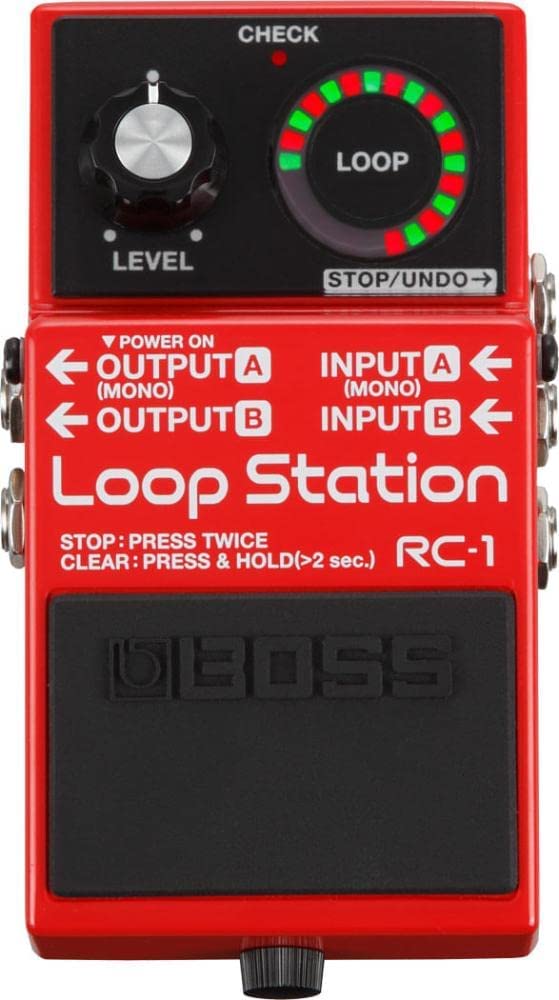
The Boss RC-1 Loop Station Pedal is a straightforward, user-friendly device.
Designed to empower musicians with simplicity, this stereo looping pedal is no frills but all thrills!
Its essence lies in its uncomplicated operation and versatility, fitting seamlessly with your pedalboard or effects system.
Ideal for any musician – whether you’re just starting or a touring professional, it’s an essential tool for practicing and perfecting your art.
It allows for easy recording, playback, overdubbing, and editing of loops.
Don’t be fooled by its simplicity; this pedal allows stereo instruments like synthesizers to be looped, expanding the horizon of your jamming sessions.
The RC-1 also offers an optional external footswitch for added convenience and flexibility.
Plus, with a whopping 12 minutes of stereo recording, you’ll have ample space for all your creative explorations.
On top of it all, it’s housed in a robust red stompbox, ensuring durability and reliability for years.
- My Review
Jumping right in with the Boss RC-1 Loop Station, it’s like getting behind the wheel of a high-performance sports car that happens to have automatic transmission.
It delivers all the excitement you’d want from a looping pedal, but the learning curve?
Practically non-existent.
With its ultra-intuitive operation, it’s as simple as tapping your foot to record, playback, overdub, or even redo loops.
Imagine yourself in the thick of a jam session, not missing a beat as you create a multi-layered stereo masterpiece.
You can even change modes and alter the order of operations to fit best your jamming style – a bit like a chef tailoring a recipe to personal taste.
Honestly, this pedal shines brighter than a supernova regarding ease of use, but that’s not where the story ends.
With stereo inputs and outputs, it’s like having an entire band at your disposal.
You can even loop in keyboards, drum machines, or microphones, turning your solo jam into a full-fledged symphony.
The RC- overall-1 is like the Swiss Army knife of loop pedals, complete with an external footswitch for additional control.
Picture yourself seamlessly adding or subtracting layers to your loops, controlling your musical canvas with the precision of a seasoned artist.
This pedal is a gem, but it’s not without quirks.
For instance, shutting it off might feel like trying to solve a Rubik’s cube.
Two quick taps should do it, but sometimes, it’s easier said than done.
Also, keep in mind that it lacks a drum looper.
So, if you want to add percussive layers, this pedal won’t be your go-to guy.
Here are the ratings I’ll give to the Boss RC-1 Loop Station Pedal:
Nonetheless, the Boss RC-1 Loop Station is a testament to how complexity and sophistication blend into a user-friendly package.
From its simplicity to ample recording time, it’s a tool that hits the sweet spot, even if it dances to its beat.
- Pros:
- Simple and user-friendly operation.
- Compact and sturdy design.
- Stereo recording capability.
- Good for beginners and professionals.
- Can be incorporated into existing pedalboard setup.
- Cons:
- No memory for saving loops (RC-3 has this feature).
- Separate footswitch required for undo function.
- No built-in drum looper.
- Some users find it difficult to shut off.
- May require additional accessories for optimal use.
My final verdict is that the Boss RC-1 Loop Station is a solid choice for musicians seeking a simple and user-friendly looper pedal.
Its compact design, stereo recording capability, and reliable performance offer versatility for guitarists, bassists, and keyboardists.
The Boss brand’s reputation for quality is evident in this product, making it a reliable choice.
However, it has some limitations, such as the lack of memory for saving loops and additional accessories for certain functions.
Nevertheless, the Boss RC-1 Loop Station offers a good overall value considering its features, performance, and brand value.
Line 6 DL4 MKII Delay Modeler With Loop Feature
MkII delays, looper, mic input, MIDI, up to 240s of looping.
This DL4 MkII delay pedal offers 30 different delay types, two looper types with up to 240 seconds of record time, an XLR microphone input, MIDI In and Out/Thru connectors, and three bypass options. The improved design is smaller and lighter than the original, making it the perfect choice for modern musicians seeking classic and cutting-edge sound.
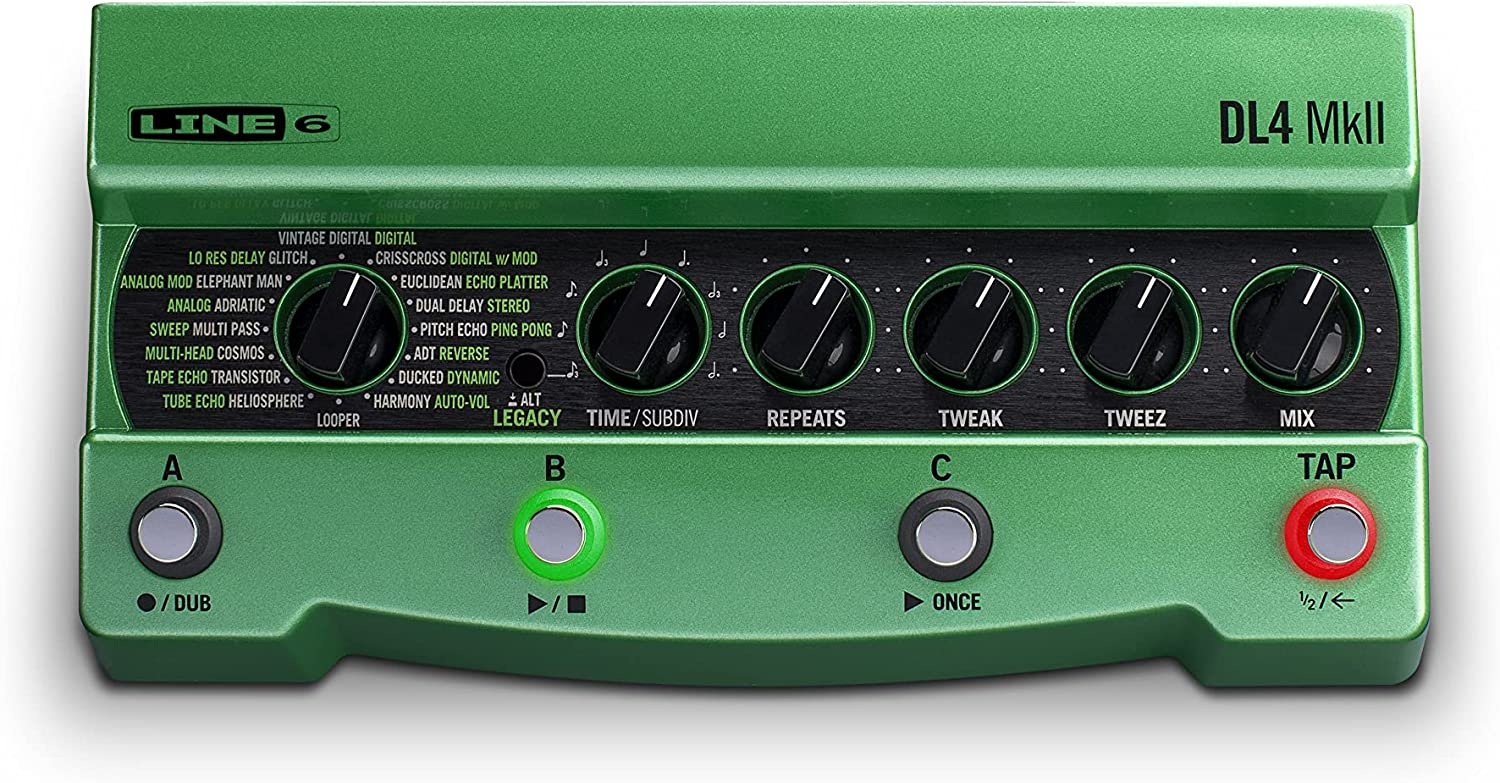
Defining the perfect blend of tradition and innovation, the Line 6 DL4 MKII Delay Modeler showcases a range of exceptional features.
Its exterior mirrors the original DL4, providing a sense of familiarity for existing users.
Equipped with 30 diverse delays, including classics from the original DL4 and 15 new versions inspired by the HX family of amps and effects processors, it offers ample choices for sound customization.
Looping capabilities have also been expanded, with two looper types and an impressive loop time of 240 seconds, extendable to several hours via a microSD card.
For enhanced connectivity, this pedal brings in MIDI In, Out/Thru connectors, can receive PC and CC messages, and is an input for an optional expression pedal or extra footswitches.
It also embraces vocalists with an XLR dynamic microphone input.
Despite the compact and lightweight design, it ensures sturdy performance through robust footswitches and multiple bypass options.
- My Review
Getting my hands on the Line 6 DL4 MKII Delay Modeler, I felt like I was holding a little green time machine.
It’s like being handed the keys to a classic car upgraded with a high-tech engine.
The familiar design is comforting, while the innovative features hint at the potential adventures ahead.
Strapping in and turning the key, I first noticed the mind-blowing variety of delays – a whole 30 of them, a veritable buffet of sound.
From the echoes of the past drawn from the DL4 to fresh offerings inspired by the HX family, it’s a treasure trove waiting to be explored.
It’s as if Line 6 has built a time portal that allows you to journey between the golden age of analog delays and the cutting-edge innovations of the 21st century.
The looping capabilities are nothing short of a sonic playground.
Two types of loopers and up to 240 seconds of record time – extendable to several hours with a microSD card – are like a blank canvas waiting for your creativity.
It’s like being able to paint with sound, layering melodies, and rhythms with the precision of a master artist.
Connectivity is robust and versatile, akin to a Swiss Army knife for the modern musician.
MIDI connectors, an optional expression pedal input, and a unique XLR dynamic microphone input make it a flexible tool in any good arsenal.
Its ability to accommodate vocal processing and looping is a standout feature, a doorway inviting more than just guitarists to the sonic party.
Despite all these features, what struck me was its surprising lightness.
It’s a powerhouse packed into a compact, easy-to-carry package.
The footswitches are sturdy, the bypass options versatile, and the product is like a sturdy tank, ready for the rigors of the road.
So, whether you’re a bedroom rocker or a touring musician, the Line 6 DL4 MKII Delay Modeler is a worthy companion, ready to accompany you on your musical journey.
Here are the ratings I’ll give to the Line 6 DL4 MKII Delay Modeler With Loop Feature:
- Pros:
- 30 diverse delay options.
- 240 seconds of looping time.
- XLR microphone input.
- Cons:
- Not compatible with batteries.
- Optional accessories needed for extended features.
My final verdict is that the Line 6 DL4 MKII Delay Modeler is an exceptional product offering a wide range of effects, impressive versatility, and diverse features.
Its sturdy construction, compact design, and MIDI capabilities provide excellent performance and allow for vocal processing and looping.
In addition, the positive user reviews and the lack of negative reviews further emphasize its quality.
Considering its brand reputation and the overall value it provides, the Line 6 DL4 MKII Delay Modeler is highly recommended for musicians seeking a reliable and feature-rich delay pedal.
Boss RC-500 Loop Station Compact Pedal
Premium looping with 13 hours of stereo recording, deep control options, and inspiring rhythms.
The RC-500 is a powerful two-track looper with 32-bit audio quality, Loop FX, 57 rhythms, and MIDI control support. It offers an intuitive interface and lots of ways to personalize your setup, ideal for guitarists, singer/songwriters, and multi-instrumentalists who want to take their looping to the next level.
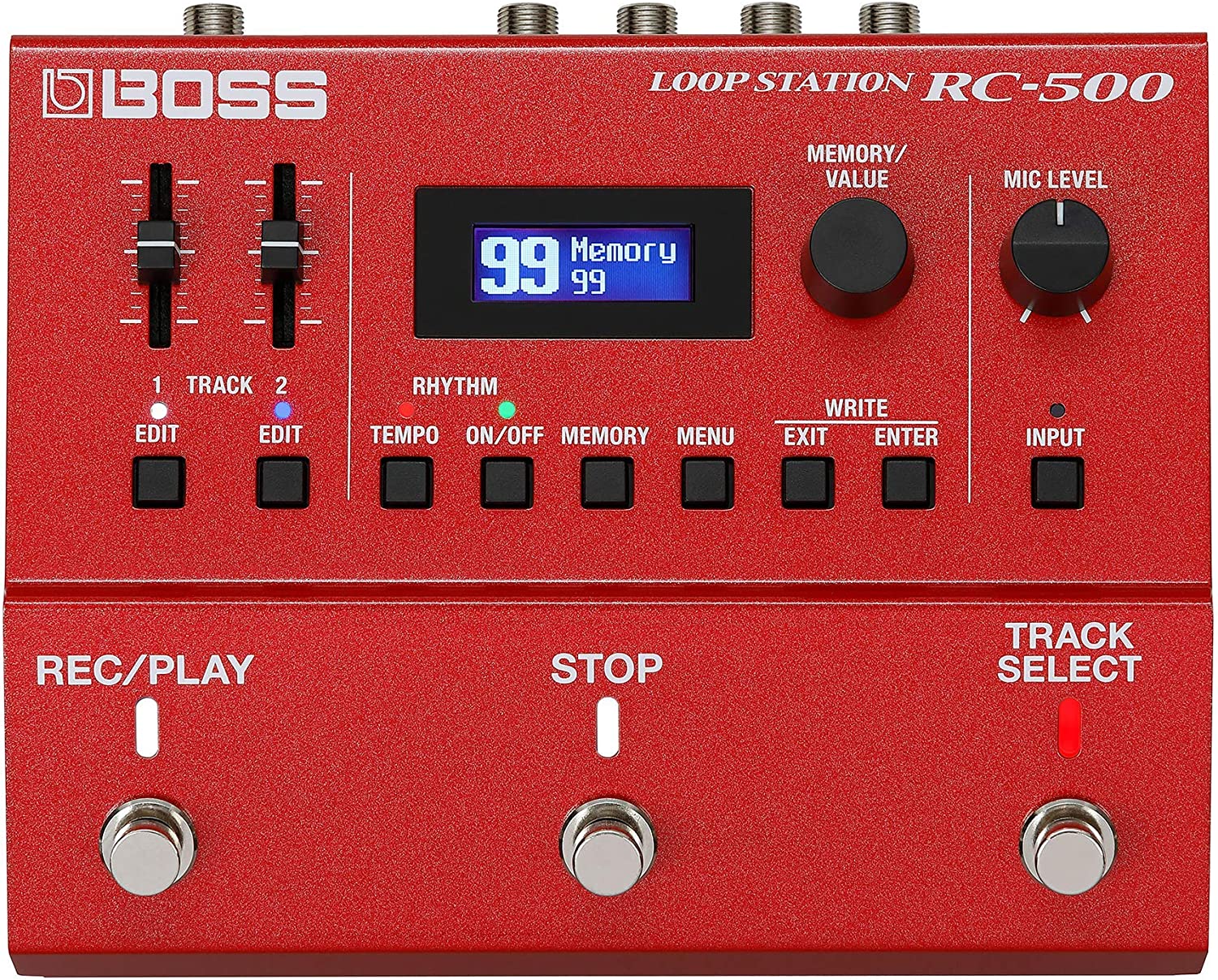
Designed for the creative and passionate musician, the Boss RC-500 Loop Station is an absolute must-have.
This dual-track looper is a powerhouse that can easily be integrated into any guitarist or multi-instrumentalist’s gear.
Its capacity to record up to 13 hours in stereo sound quality ensures your sessions are captured in high fidelity.
Equipped with various rhythm tracks and a handy USB input/output feature, this compact unit caters to many needs.
Furthermore, it comes with a MIDI I/O, allowing you to connect other MIDI-enabled devices for even greater flexibility.
What makes the RC-500 stand out is its impressive 32-bit audio quality, ensuring that your sound remains crystal clear even with multiple overdubs.
Compact yet loaded with features, the RC-500 Loop Station is ready to become your essential partner in music creation, providing you with the tools to turn your musical ideas into reality.
- My Review
Stepping into the musical universe with the Boss RC-500 Loop Station, I was immediately struck by its compact size.
A robust device, comfortably fitting into my gear set-up, but don’t be fooled by its compactness.
Instead, i like opening a small box and finding an entire music studio inside.
My first impressions centered on the Loop StaStation’speccable 32-bit sound quality.
Every strum, every beat, and every note I looped resonated with the same clarity as my original recordings.
It felt like I was sitting in a high-end recording studio, not in front of a small device on my pedalboard.
Exploring its features further, I found the 13-hour recording capacity quite extraordinary.
With that amount of recording time, there’s an entire galaxy of creative possibilities.
It’s like having an open road ahead for a sonic journey without the fear of running out of gas.
One feature I loved was the dual-track looper.
It’s like a musical partner on standby, ready to take over when needed.
I could layer my loops, creating intricate musical textures that would otherwise require a full band.
With the RC-500, I found the freedom to experiment with my sound, exploring new musical ideas previously out of my reach.
Regarding connectivity, the MIDI I/O broadened the RC-500’s horizon.
It was akin to opRC-500’se door to a world where other MIDI-enabled devices could join the party.
Having that extra versatility made the device a linchpin in my creative process.
However, the loop station wasn’t without its flaws.
Here are the ratings I’ll give to the Boss RC-500 Loop Station Compact Pedal:
The included rhythms felt restrictive and could be more diverse to cater to various musical styles.
But all things considered, the Boss RC-500 Loop Station was like a Swiss army knife in my musical toolbox – indispensable, multi-faceted, and reliable.
- Pros:
- High-quality sound with 32-bit processing.
- Long stereo recording time (13 hours).
- Versatile I/O and easy-to-use interface.
- Ability to personalize setup and assignments.
- Inspiring rhythms and loop effects.
- Cons:
- No rubber feet, slides easily on surfaces.
- Some users find certain effects to be less useful.
- Rhythm tracks may sound similar and lack variety.
- Serial tracks require the same number of measures.
- Issue with tempo sync when using sequential loops.
My final verdict is that the Boss RC-500 Loop Station Compact Phrase Recorder Pedal is a highly versatile and feature-rich looping device with excellent sound quality.
In addition, it offers various options for musicians, including versatile I/O, inspiring rhythms, and loop effects.
While some minor drawbacks are reported by users, such as sliding on surfaces and limited software configuration options, overall, the RC-500 delivers on its promises.
It provides a valuable tool for looping and recording.
Considering its brand reputation, performance, and value, the Boss RC-500 Loop Station Pedal is recommended for musicians seeking to enhance their looping capabilities.
Pigtronix Infinity 3 Deluxe Looper Pedal
Latency-free looping with 24-bit HD recording, 3 hours recording time, MIDI-sync options, and more.
Infinity 3 is a powerful and flexible looping pedal with latency-free recording, instant playback, and 24-bit HD recording. It features synced and parallel playback, comprehensive MIDI control, and up to 3 hours of recording time on 50 loop pairs. Its discrete analog limiter stages and analog pass-through provide superior sound quality.
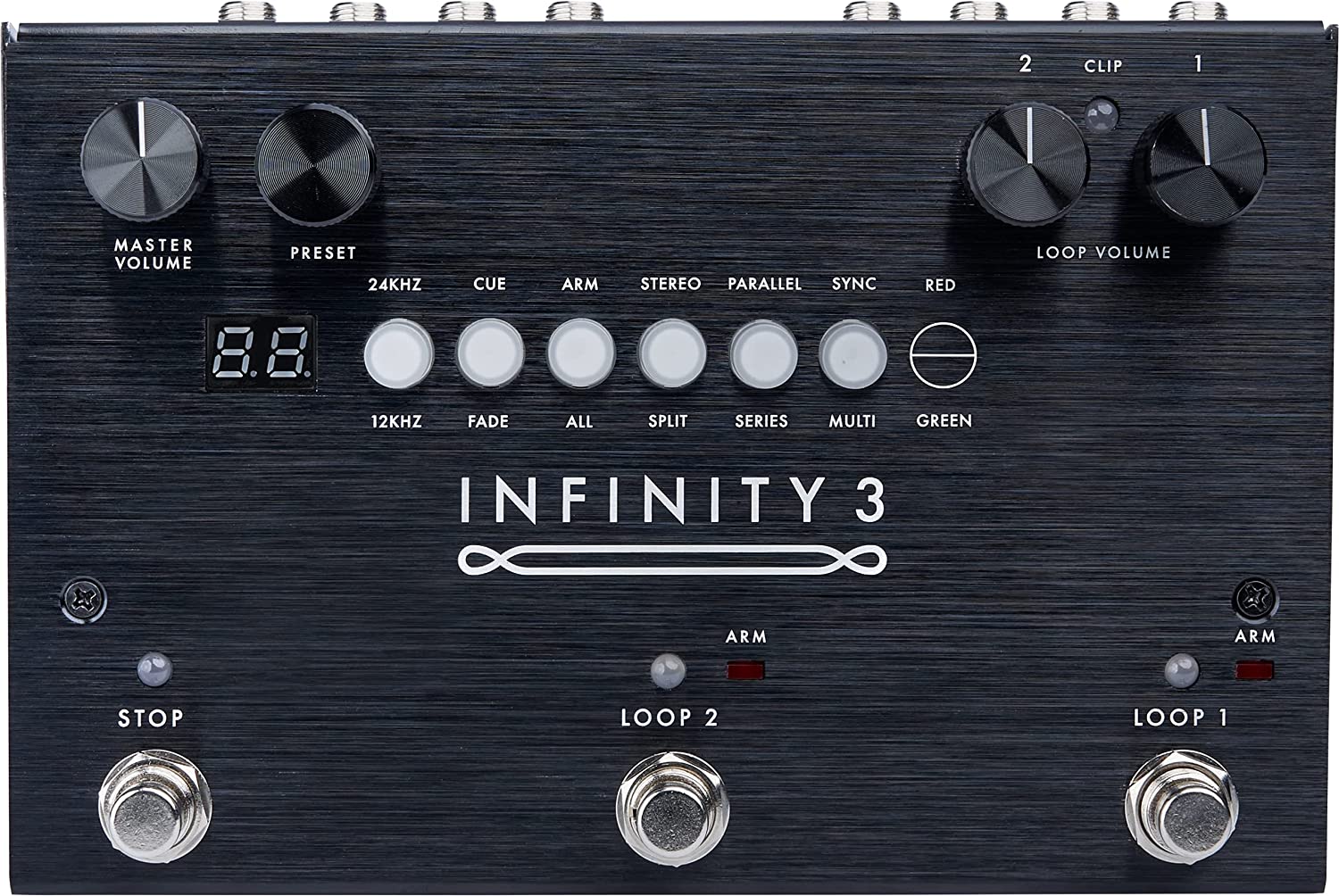
Infinity 3, crafted by Pigtronix, is a unique fusion of simplicity, power, and flexibility in musical looping pedals.
This advanced device makes your creative journey effortless, assuring instant response and zero-latency looping.
In addition, its capability to record up to three hours across 50 loop pairs showcases its capacity for creative depth.
As a versatile tool, it offers complete MIDI control and smart MIDI clock jitter rectification, facilitating connection to a Digital Audio Workstation, Drum Machine, or other pedal effects.
Its Red/Green key is a noteworthy feature linked to the central buttons.
This key indicates the active feature depending on the color – red for the top feature and green for the bottom.
Further enhancing its versatility, Infinity 3 supports stereo split inputs and advanced features through the Pigtronix Universal Remote.
In terms of design, it comes in a green, transparent, and red color scheme, measuring 9 x 6 x 4 inches and weighing a pound.
This hi-fi stereo double looper pedal has discrete analog limiter stages, transparent analog pass-through, and a 24-bit HD recording engine with a variable sample rate for a superior sound experience.
Its ability to increment sample rates in semi-tones over two octaves sets a new standard for looping pedals.
- My Review
Jumping right into the heart of it, the Pigtronix Infinity 3 Deluxe Looper Pedal feels like a dream come true for those seeking a smooth, musical looping experience.
I was astounded by its inherent simplicity despite the multitude of features it houses.
The pedal offers a rapid, lag-free response that brings the feeling of holding a musical paintbrush, allowing you to craft audio masterpieces on a whim.
Though a mere pound in weight, this pedal is a heavyweight in capabilities.
With an impressive 3-hour recording capacity spread over 50 loop pairs, it feels like a veritable canvas of musical exploration at your feet.
It’s like having a well-stocked art studio where you can paint intricate sonic portraits.
But this isn’t all about individual exploration – its comprehensive MIDI control, like a well-trained maestro, seamlessly orchestrates synchronization with a DAW, Drum Machine, or other pedals, ensuring a harmonious ensemble performance.
I must commend the design thoughtfulness of the Red/Green key – it’s like a traffic light, directing the flow of features.
It’s a minor detail, yet it significantly enhances the ease of use.
When I first switched on the pedal and saw the Red/Green illumination, it was as intuitive as tying my shoelaces – red indicating the active top feature, green for the bottom one.
Switching gears to sound quality, the Infinity 3 is no less than an orchestra at your command.
The discrete analog limiter stages, transparent analog pass-through, and 24-bit HD recording engine collaborate like a well-conducted symphony, creating a sublime audio experience.
Moreover, the ability to adjust sample rates in semi-tones over two octaves feels like holding a sonic microscope, offering unparalleled control over your sound.
Here are the ratings I’ll give to the Pigtronix Infinity 3 Deluxe Looper Pedal:
However, I did notice the lack of a built-in guide or tutorial, which could leave beginners feeling like they’re steering a spaceship without a map.
Despite that, it doesn’t take too long to learn the ropes, and once you do, you’ll find the Pigtronix Infinity 3 to be a steadfast companion on your musical journey.
- Pros:
- Simple to operate
- 3 hours of recording time
- Comprehensive MIDI control
- Cons:
- No specific cons mentioned
My final verdict is that the Pigtronix Infinity 3 Deluxe Hi-Fi Stereo Double Looper with Midi Guitar Pedal is an excellent choice for musicians seeking a powerful and versatile looping pedal.
Its simple operation, comprehensive MIDI control, and impressive recording time offer great value for its price.
In addition, the pedal’s performance, brand reputation, and tonal quality enhance its appeal.
Overall, it is a highly recommended option for musicians looking to enhance their looping capabilities.
LEKATO Guitar Looper Pedal
Create and layer captivating loops with extended recording time.
With 9 loops and a single loop recording duration of up to 10 minutes, you have a total recording time of 40 minutes at your fingertips. Enjoy professional tone quality and a visual time indicator for a superior audio experience. Easily import/export your music to/from a PC via USB, and control loop playback volume with a single knob. Get ready to explore endless possibilities and take your music to new heights with this feature-packed looper.
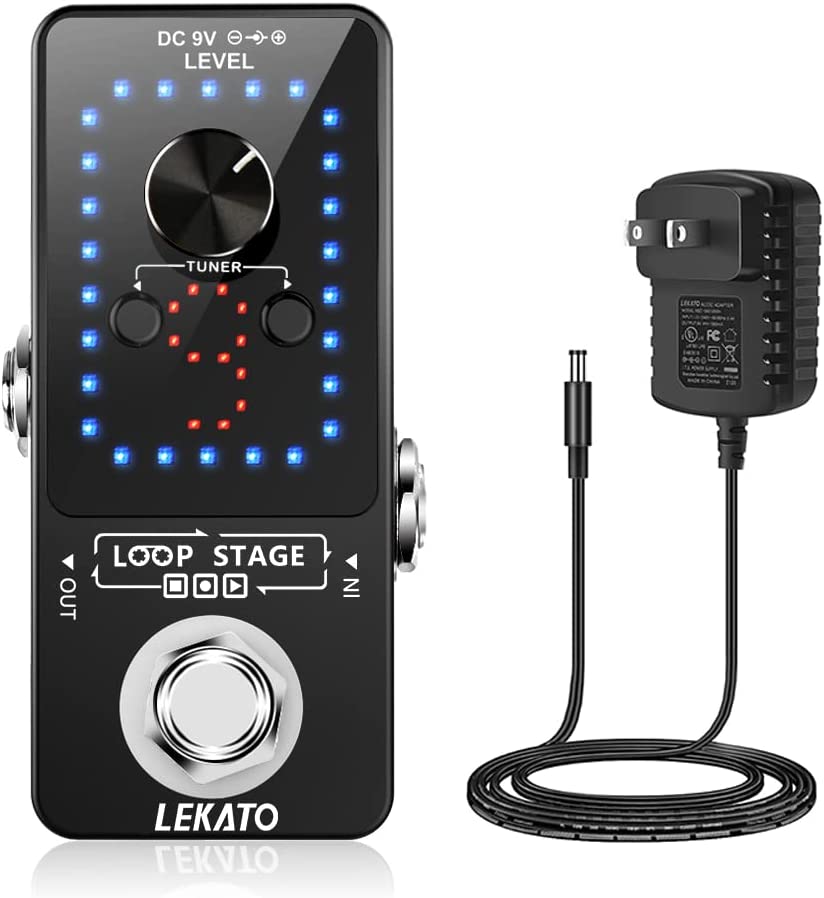
The LEKATO Guitar Looper Pedal Effect Pedal is a compact and stylish device with much going for it.
This nifty gadget is adorned in a sleek 9 Looper Black color and runs on a 9V, 0.6A power supply.
It is designed to make your guitar sessions more immersive with nine separate loops, each allowing for a 10-minute recording and 40 minutes of recording time.
This pedal offers a 48K/24bit sampling rate for those who crave top-notch audio quality, ensuring lossless, uncompressed audio.
Its inbuilt tuning function is highly sensitive and smoothly continuous, preventing any jarring interruptions between phrases.
In addition, this little powerhouse simplifies loop playback volume control with a user-friendly single-knob operation.
The pedal shines in its adaptability as well.
With a handy USB connection, you can easily import or export your music to or from a PC, which is especially helpful for uploading or downloading .wav loop files.
As a bonus, you can also benefit from its unlimited overdubbing feature, which lets you record, undo or redo, stop, and erase via various foot commands.
- My Review
When I saw the LEKATO Guitar Looper Pedal Effect Pedal, I knew I was in for a ride.
Sporting a stylish black finish, this device immediately conveys a sense of elegance and sophistication.
Now, looks aren’t everything in music, but they certainly don’t hurt!
Once I started using this gadget, I was struck by its sheer capacity for sound recording.
I mean, nine individual loops with 10 minutes of recording each?
That’s like having a symphony at your feet!
It’s a veritable buffet of sound where you can take your pick and craft your music as you, please.
Regarding audio quality, this pedal is no slouch, either.
It delivers a 48K/24bit sampling rate, which, in layperson’s terms, means it’s like having a professional recording studio on your pedalboard.
And the in-built tuning function?
A lifesaver for those high-stakes sessions where every note counts.
Now, the one thing that had me scratching my head was the user interface.
Navigating the features with a single-knob operation seemed like solving a Rubik’s cube at times, but after a bit of trial and error, I managed to get the hang of it.
Transferring music files to and from the pedal was a breeze with the USB connectivity, a feature that felt like a cherry on top of an already impressive cake.
The unlimited overdubbing feature was the icing that allowed you to experiment, undo, redo, and erase to your heart’s content.
But alas, every rose has its thorns.
There were times when a bit of noise seemed to creep into the recording, which, as you can imagine, was a tad frustrating.
However, weighing the pros against the cons, this pedal proved to be more than just a pretty face.
Here are the ratings I’ll give to the LEKATO Guitar Looper Pedal:
It’s a competent and versatile tool for musicians looking to expand their creative horizons.
Despite its minor quirks, it’s a reliable companion offering much more than its modest price tag suggests.
- Pros:
- Clear looping with unlimited overdubbing.
- High-quality audio with professional tone quality.
- Built-in high sensitivity tuning function.
- Easy upload and download of loop files via USB.
- Compact and intuitive user experience.
- Cons:
- Potential grounding issue causing feedback noise.
- Some users experienced buzzing or noise issues.
- Occasional reliability issues with the electronics.
- One user reported the product dying after a year.
My final verdict is that the LEKATO Guitar Looper Pedal Effect Pedal is a versatile, feature-rich product with high-quality audio and a user-friendly experience.
While it may have occasional noise and reliability issues, overall, it provides good value for its price.
The brand has received positive feedback from users, and the pedal’s compact design and included accessories make it a convenient choice for musicians.
With a solid score in versatility, features, performance, brand, and value, this pedal is worth considering for guitarists looking to enhance their looping capabilities.
TC Electronic DITTO Looper Pedal
True bypass, intuitive looper pedal with 5 minutes of looping time.
DITTO LOOPER is an intuitive and user-friendly looper pedal featuring 5 minutes of looping time, True Bypass, and Analog-Dry-Through. Its one-knob interface provides easy access to Record, Undo/Redo, Stop, and Erase functions, delivering a high-quality 24-bit uncompressed audio experience.
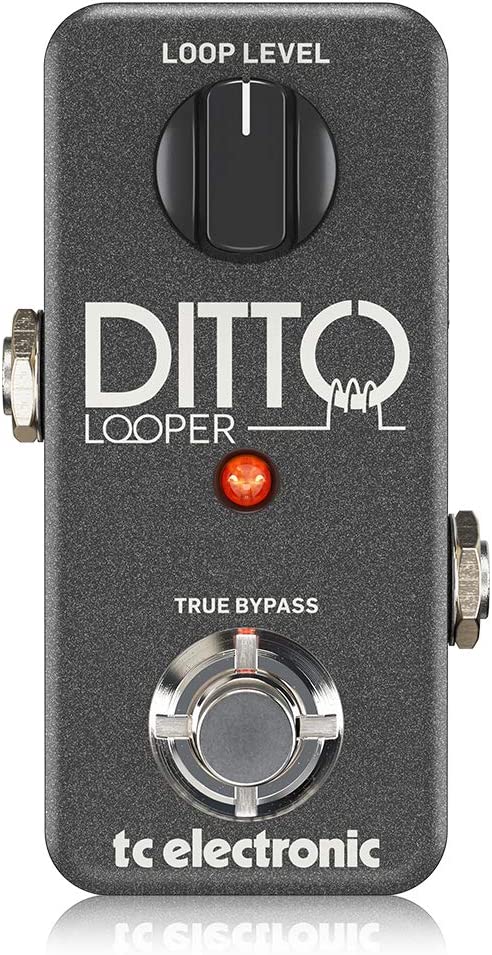
The TC Electronic’s DITTO Looper Pedal is a compact yet versatile gadget for exploring musical creativity.
Designed for guitarists, it aims to deliver a seamless performance experience.
Within its sleek, minimalist frame, you’ll find an intuitive one-button interface making it super easy to operate.
True bypass and Analog-Dry-Through technology maintain the integrity of your original tone without any conversion, ensuring a clean, unadulterated sound even when the pedal is off.
In addition, an impressive 5 minutes of looping time and unlimited overdubs make this pedal a true workhorse for any musician.
Despite its compact size, a ton of power is packed into this tiny pedal.
And to top it off, its construction is solid and built to last, even under rigorous use.
- My Review
Having personally put the TC Electronic DITTO Looper Pedal through its paces, I can tell you it is a small beast in a compact package.
First off, simplicity is a virtue that this pedal wears like a badge of honor.
With just one button and a single knob, it feels like a child’s toy, yet this thing has the heart of a lion.
It’s like a secret weapon hidden in your pocket.
Navigating its features, I found the single-button operation quite ingenious.
It took a bit of time to master the sequence of presses and holds, but once I got the hang of it, my creativity was only limited by the boundaries of my imagination.
A tap here, a hold there, and the music began to flow like water.
It’s akin to learning a new language – a bit tricky at first, but oh, so rewarding once you get the hang of it!
Something that impressed me was the 5 minutes of looping time.
It felt like having an open field to run in, offering ample room to layer and explore.
And with unlimited overdubs, it’s like painting on a canvas where the colors never run out.
Sound quality, of course, is paramount.
In my experience, the pedal shone like a diamond in this regard.
The True Bypass and Analog-Dry-Through ensured my tone remained unscathed, as pure as morning dew.
However, everything is not always perfect and positive.
One potential hurdle could be the lack of a separate stop/clear button which could take a while to get used to, especially in a live gig setting.
But that’s just part of the charm, like learning to dance with a partner with an unusual step.
The DITTO Looper Pedal is like a Swiss Army knife for any guitarist – a nifty little tool that, despite its simplicity, is chock-full of musical potential.
Here are the ratings I’ll give to the TC Electronic DITTO Looper Pedal:
Its imperfections add character, and its performance speaks volumes.
It’s a trusty companion on any musical journey.
- Pros:
- Durable and well-built
- Allows unlimited overdubs and undo/redo
- Analog-Dry-Through design preserves tone
- Compact and space-saving
- Can synchronize with other devices via MIDI
- Cons:
- No power supply included
- Footswitches may be close together for some users
- Double tap required to stop individual loops
- Limited built-in effects
- No on/off switch
My final verdict is that the TC Electronic DITTO LOOPER is a highly intuitive and well-designed looper pedal with great sound quality.
It offers easy operation and a compact footprint, making it suitable for guitarists of various skill levels.
The pedal’s unlimited overdubs, undo/redo functionality, and analog-dry-through design contribute to its versatility.
While it may lack certain features and built-in effects compared to more advanced loopers, it offers a solid performance at a relatively affordable price.
The TC Electronic DITTO LOOPER earns a positive recommendation for its user-friendly interface, sound quality, and value for money.
Boss RC-10R Looper Pedal
Compact, creative looping with 99 phrase memory and MIDI I/O.
The RC-10R Loop Station is a real-time creation machine, equipped with two song sections, intros/endings, and a vast rhythm library for live performances, songwriting, and practice. It features 280 rhythms, onboard storage for 99 phrase memories, and MIDI I/O for external control.
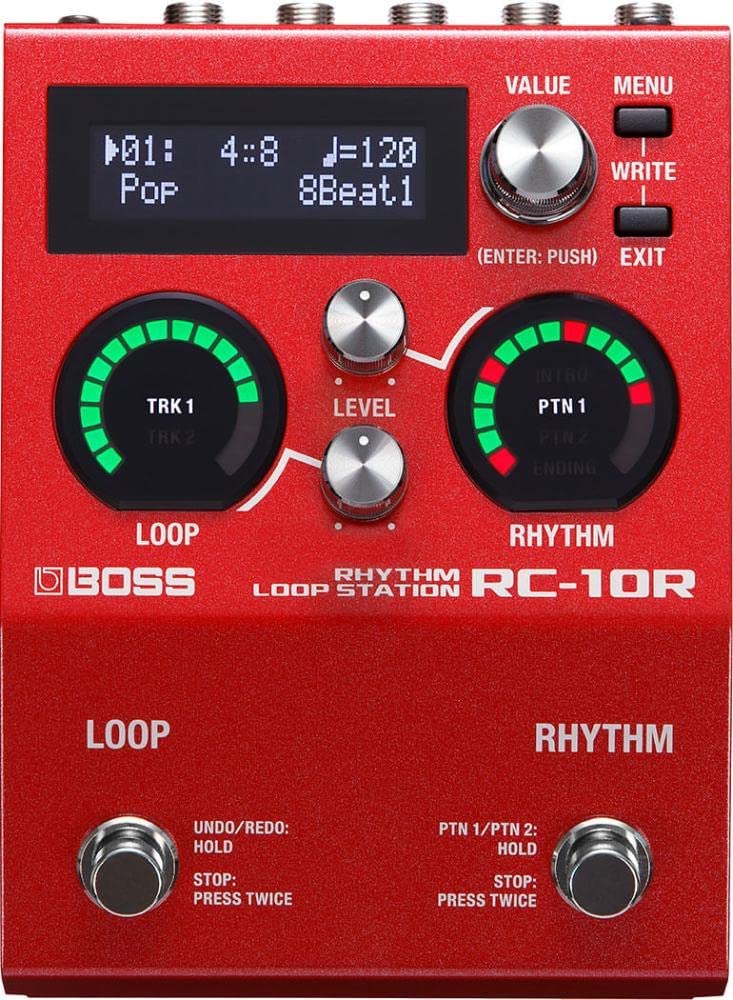
The Boss RC-10R Looper Pedal is a compact, high-quality device designed to elevate your live performances, songwriting sessions, and daily practice.
With a 44.1 kHz sampling frequency and 32-bit AD/DA conversion, this next-generation Loop Station delivers impressive sound quality for recording and playback.
With 280 built-in rhythms, it offers diverse patterns to suit any music genre.
In addition, you can import your custom rhythms, making it perfect for personalizing your sound.
One notable feature of the RC-10R is the onboard storage for up to 99 phrase memories, providing ample space to store your loops and tracks.
In addition, the full MIDI I/O with space-saving mini TRS jacks ensures that syncing with other devices is straightforward and convenient.
The pedal comes in an eye-catching red and silver color scheme, and its compact dimensions (22.05 x 16.14 x 9.65 inches) and lightweight design (0.88 kilograms) make it an excellent addition to any musician’s gear.
- My Review
I recently had the opportunity to experience the Boss RC-10R Looper Pedal, and I must say, it’s quite a game-changer.
This little powerhouse has features that make it an essential tool for any live performer, songwriter, or just someone looking to enhance their daily practice routine.
The sound quality of the RC-10R is superb, thanks to the 44.1 kHz sampling frequency and 32-bit AD/DA conversion.
It doesn’t matter whether you’re recording or playing back, this Loop Station delivers a crisp and clear audio output.
One feature that caught my eye was the vast library of 280 built-in rhythms, which spans various music genres.
This, coupled with the ability to import your custom rhythms, makes it a versatile device that can cater to any musical taste.
It was like having a treasure trove of groovy beats to explore.
My major selling point was onboard storage, which saves up to 99 phrase memories.
This significantly expands the creative possibilities when working on different song compositions or practicing various techniques.
And with the full MIDI I/O and mini TRS jacks, integrating the pedal with other devices is a breeze.
That being said, I found that the RC-10R does have a bit of a learning curve.
Although the controls were intuitively laid out, novice users may need time to tweak each setting to perfection.
Moreover, with only two tracks available, it might limit professionals to more elaborate arrangements.
Ultimately, I consider the Boss RC-10R Looper Pedal a worthwhile investment – like having a compact, all-in-one band at your feet!
Here are the ratings I’ll give to the Boss RC-10R Looper Pedal:
Despite minor limitations, its impeccable sound quality, versatile rhythm library, and rich feature set make it stand out in the world of loopers.
I’d recommend this pedal to fellow musicians seeking something fresh and innovative to elevate their performances.
- Pros:
- High-quality sound and playback.
- Versatile library of rhythms.
- Convenient onboard storage.
- Cons:
- Steep learning curve for novices.
- Limited to two tracks.
- May require additional external controls.
My final verdict is that the Boss RC-10R Looper Pedal is an excellent addition to any musician’s equipment, offering versatility, impressive sound quality, and a wealth of features.
With its incredible range of built-in rhythms and the ability to import your versatile library, it stands out in the competitive world of looper pedals, making it ideal for live performances, songwriting, and practice.
However, despite the slight learning curve for novice users and limited track options, this pedal’s overall benefits and high quality outweigh these small drawbacks.
It’s a reliable, compact, and powerful companion for musicians who aspire to improve their sound.
LAMMA FC01 Drum Machine Phrase Loop Pedal
Flamma FC01 Drum Machine Phrase Loop Pedal offers tap tempo, 16 drum grooves, 20 min looper capacity, and separate playback level control.
FLAMMA’s FC01 is a versatile pedal designed for musicians of any skill level. It features three modes: Drum Machine, Looper, and Drum + Looper, offering a wide range of creative options. It is equipped with a Mode Switch, Top Panel, Rhythm List, and Specifications, making it easy to create powerful sounding loops and beats. With its compact size and low cost, the FC01 is an ideal choice for any musician looking to expand their sonic capabilities.
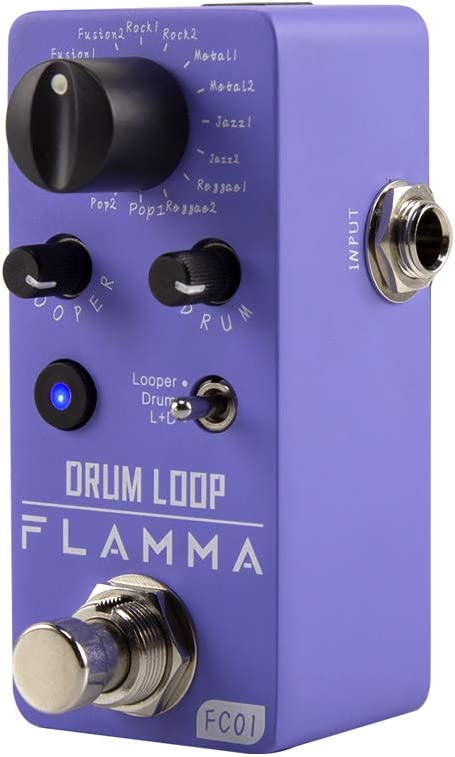
The FLAMMA FC01 is a compact drum machine loop pedal designed to enhance your musical creations with various drum grooves and loops.
Available in a sleek DrumLoop Purple color, the pedal has a user-friendly interface and is lightweight, weighing only 153 grams.
One of the main attractions of this pedal is its dual functionality, featuring a standalone looper and a drum machine module that can work together.
It offers 16 drum grooves, consisting of 8 groove styles with two variations of each.
With a 20-minute looper capacity, you have ample time to record and experiment with your sounds.
The playback levels for the looper and drum machine can be controlled independently, giving you greater creative control.
You can also set the tempo of the drum machine by tapping the dedicated tempo button in rhythm with your desired groove.
In addition, the compact product has dimensions of 1.85 x 3.27 x 2.05 inches, allowing easy integration into your existing setup.
- My Review
As someone who values creativity and versatility in music-making, I found the FLAMMA FC01 Drum Machine Loop Pedal an excellent tool worth exploring.
The high-quality construction and compact, lightweight design make it easy to integrate into any setup.
With the dual functionality of simultaneously working as a standalone looper and a drum machine, this pedal offers plenty of options for musicians.
The 16 drum grooves cover a wide spectrum, satisfying various preferences and bringing out the rhythmic essence in any tune.
While the 20-minute looper provides sufficient space for experimentation and refining sound, one feature that truly caught my attention was the independent power of volume control.
Having the ability to adjust the playback levels of both the looper and drum machine separately was akin to fine-tuning the perfect harmony.
It felt like discovering a secret ingredient to my special musical recipe.
When playing around with tempos, the tap tempo button was a convenient addition to the pedal – setting the beat rhythm just by tapping, nailing the ideal tempo to flow with my melody, and making it as simple as a few taps of the foot.
Like with any valuable tool, some aspects could see improvement.
For example, syncing the loop with the drum machine took some getting used to, and having a bpm dial instead of just using ‘tap’ to set the speed would be quite helpful.
Also, the absence of an actual dial for tempo adjustments meant some extra effort in attaining the precise tempo.
Here are the ratings I’ll give to the LAMMA FC01 Drum Machine Phrase Loop Pedal:
But in the grand musical symphony, these minor issues were like short notes, momentarily grabbing attention but easily forgotten in the seamless fusion of looper and drum machine capabilities.
As a result, for every musical journey, the FLAMMA FC01 Drum Machine Loop Pedal proved an engaging, diverse, and dynamic travel companion.
- Pros:
- Dual functionality: looper and drum machine.
- 16 diverse drum grooves available.
- Separate volume controls for looper/drums.
- Cons:
- No BPM dial, tap tempo only.
- Loop and drum sync learning curve.
- Troubleshooting needed for tempo accuracy.
My final verdict is that the FLAMMA FC01 Drum Machine Loop Pedal is a versatile and valuable addition to any musician’s gear, with room for improvement in specific areas such as tempo control.
It delivers impressive creativity and control for a compact, budget-friendly pedal.
VSN Twin Looper Electric Guitar Pedal
VSN Twin Looper Pedal, 10 minutes of looping, 11 play types, hi-fi sound.
Twin Looper Guitar Pedal provides 11 play modes, reverse loop, 10 minutes looping time, stereo input and output, true bypass and Hi-Fi sound. Small, sturdy and well-built with full metal case, this pedal is perfect for subtle performances or jaw-dropping shows.
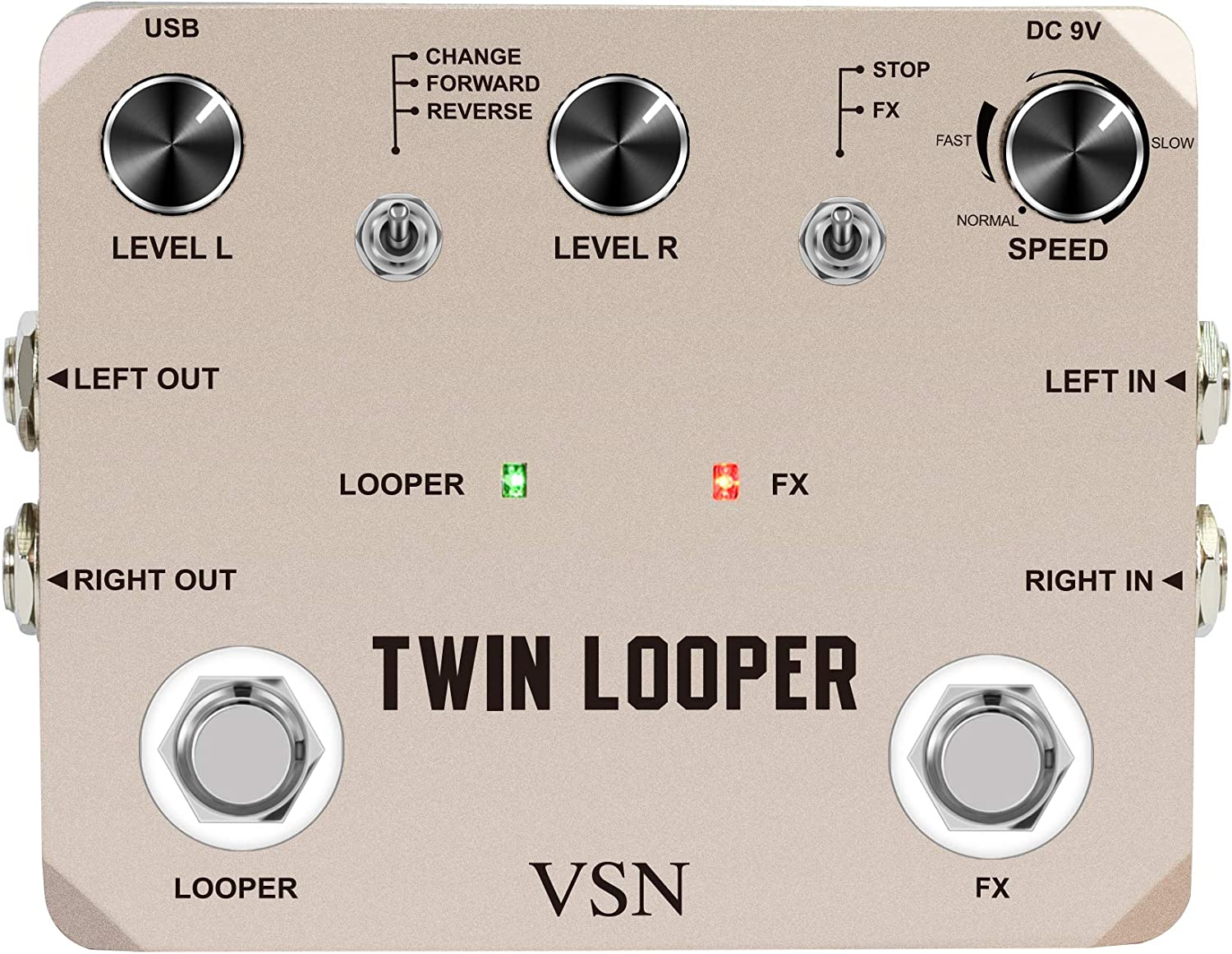
Crafted with care, the VSN Twin Looper pedal is an amazing tool for guitar enthusiasts.
This electric guitar pedal brings creativity and innovation to the music world.
Its primary feature is its dual-looping functionality that allows musicians to overlay multiple layers of sound.
This lends a vibrant texture to any composition, providing musicians with a sophisticated way to explore their artistry.
Its built-in decay control sets this pedal apart, allowing the layers to fade out slowly over time for a unique and engaging sound.
In addition, its aluminum alloy shell ensures durability and longevity, making it a trustworthy companion for your gigs.
Meanwhile, its ultra-precise pedals provide an excellent response, making creating and managing loops easy.
Another standout feature is its 10-minute recording time, a boon for those long jam sessions.
You can also expect unlimited overdubbing, offering a limitless expanse for your musical expression.
With the VSN Twin Looper pedal, guitarists can immerse themselves in musical possibilities.
- My Review
As I experimented with the VSN Twin Looper pedal, I realized that it opened up a new realm of musical possibilities for me to explore.
Much like a painter with a palette of colors, this pedal gave me a broad range of sonic textures to work with.
In addition, its dual-looping capability was akin to having a trusty sidekick, easily capturing and repeating my riffs.
This pedal’s rugged aluminum shell spoke volumes about its durability, inspiring confidence each time I tapped its responsive pedals.
It felt like a reliable old friend you know will have your back, rain or shine.
Navigating its features felt as smooth as a ride in a luxury car.
The decay control, for instance, was like a soft dimmer switch on a cozy lamp, allowing my layered soundscapes to fade into the ether gradually.
This added an extra layer of magic to my compositions, letting them echo on long after I’d strummed the last chord.
What truly stood out, however, was its 10-minute recording time.
In this vast expanse, it felt like being given an empty canvas and all the time in the world to fill it with my musical ideas: no rush, no pressure, just pure creation.
It wasn’t all roses, though.
While the unlimited overdubbing feature felt like a gift from the musical gods, it also felt like a double-edged sword.
With no constraints, losing oneself in the maze of overlapping loops could be easy.
Despite that minor hiccup, I found the VSN Twin Looper pedal an amazing companion in my musical journey.
Here are the ratings I’ll give to the VSN Twin Looper Electric Guitar Pedal:
It offered a unique blend of innovation and control, leading to a symphony of sounds I could command with just a tap of my foot.
A genuine game-changer, it was like having a mini recording studio at my fingertips.
- Pros:
- 10 minutes of looping time.
- Compact and sturdy construction.
- Offers 11 types of play.
- Allows reverse and variable speed looping.
- True bypass and analog dry-through.
- Cons:
- Potential issue with uneven fade-out on repeats.
- Some users found the LED lights to be too bright.
- Intermittent power-up glitch causing loud and distorted playback.
- Minor user-unfriendly interface.
- Power adapter not included.
My final verdict is that the VSN Twin Looper Electric Guitar Effect Pedal Loop Station is a highly versatile and feature-packed pedal with a great tone and solid performance.
It offers various looping capabilities, including reverse and variable speed looping.
In addition, the pedal’s construction is compact and sturdy, making it suitable for live performances and studio use.
While some minor concerns were mentioned in the reviews, such as potential uneven fade-out on repeats and bright LED lights, the product provides excellent value for its price.
BOOMERANG III Guitar Looper Pedal
The Boomerang III Looper Pedal provides ultimate flexibility with four distinct play styles, high-quality sounds and easy setup.
This looper guitar pedal offers up to 35 minutes of looping time with multiple Play Styles, Sample Rates, and a Decay Rate Knob for ultimate flexibility. Connect an external MIDI clock source and use the Thru Mute Function to mute the live signal for heightened loop playback.
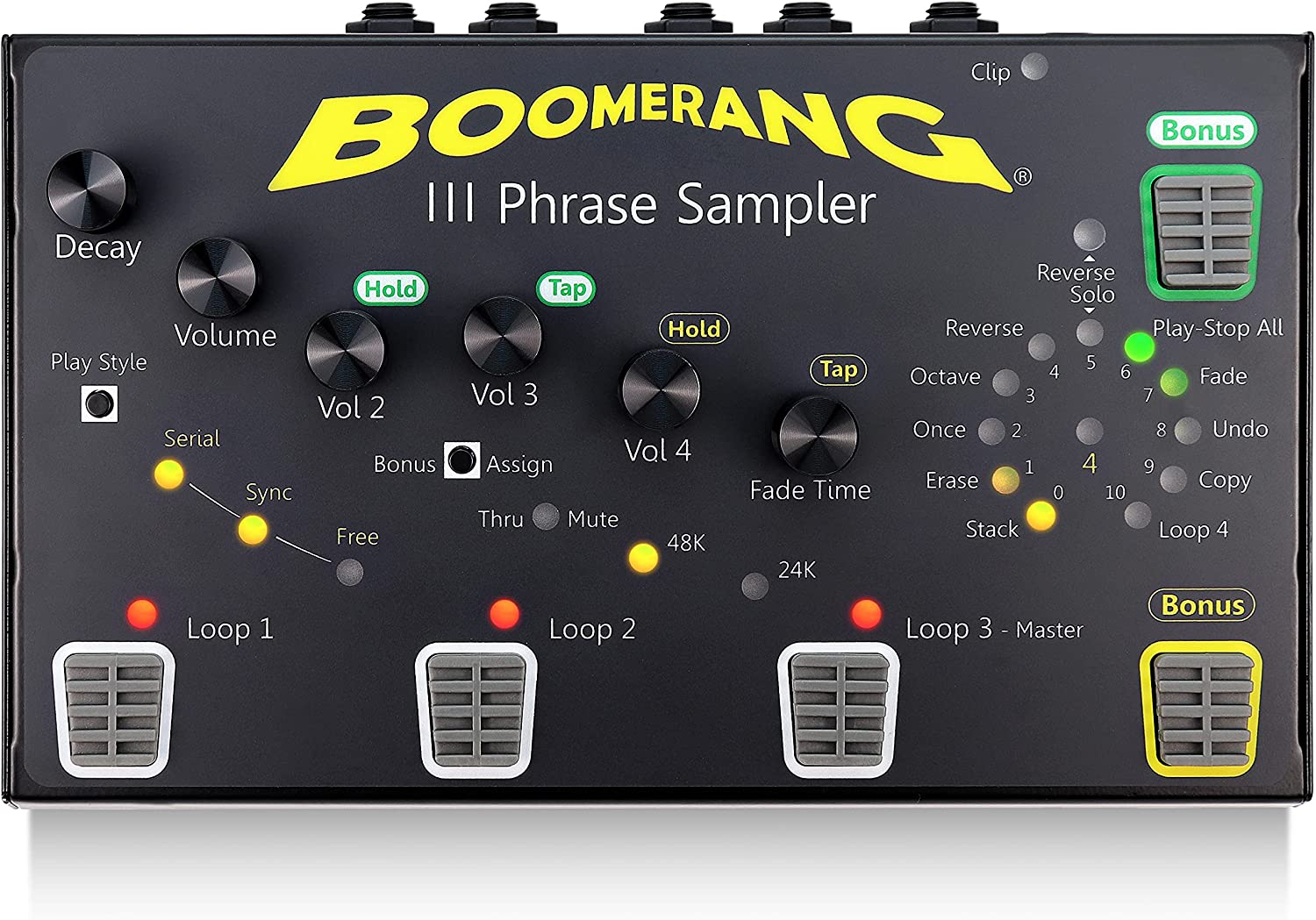
The BOOMERANG III Guitar Looper Pedal is a compact piece of equipment, colored in striking yellow and black, and sits comfortably on a small pedal board.
It’s specifically engineered for an array of musicians, accommodating not just electric or acoustic guitars but also bass, microphone, keyboards, violins, or any instrument with a 1/4-inch jack.
Its design emphasizes user-friendliness, ensuring you can start looping and creating music straight out of the box.
Key to its functionality is a high-quality processor that promises excellent sound quality at two selectable sample rates of 48KHz or 24KHz. The pedal offers the versatility of creating and managing up to four loops simultaneously, with a great max recording time of up to 35 minutes.
Additionally, it can easily sync with an external MIDI clock source.
Other features, such as stacking, Undo/Redo, Octave, Reverse, and independent volume control, make this pedal a flexible tool for practice and live performances.
It comes packaged with a 9V DC wall adaptor and four AC clips for US, EU, AU, and UK standards.
- My Review
When I started using the BOOMERANG III Guitar Looper Pedal, I was immediately impressed by how intuitive it is.
It’s not just a pedal, it’s like a reliable companion that is always ready to assist during a performance or practice session.
It was a breeze starting to jam with it – almost like picking up a familiar tune.
The straightforward controls enabled me to concentrate on what mattered most – the music.
And boy, does it deliver on sound!
Imagine a freshly baked loaf of bread, warm and inviting; that’s the audio quality of this looper pedal.
Whether in the quiet of your home or the echoing expanse of a studio, its sonic quality remains unswerving.
Diving deeper, the flexibility it offers is comparable to an Olympic gymnast.
Want three loops? Or four? It’s got you covered.
With a recording time that rivals the length of some TV episodes (up to 35 minutes), I never felt constrained.
There’s also a delightful freedom in connecting to an external MIDI clock source.
However, as much as it shines in various areas, the BOOMERANG III is not without its quirks.
One minor hiccup is its size.
Compared to a paperback book, it’s relatively compact, but working with a small pedalboard might feel like squeezing a square peg into a round hole.
Moreover, while it strives for user-friendliness, it’s like learning a new language – certain features aren’t quite as intuitive and might require more time to master.
But, once you get the hang of it, you’re flying.
Despite these quirks, the BOOMERANG III holds its ground.
This pedal is built like a tank, reassuringly solid and ready to accompany you on your musical journey.
Here are the ratings I’ll give to the BOOMERANG III Guitar Looper Pedal:
With many features tucked under its belt, it felt like a virtuoso’s secret weapon.
It might take some time to unlock its full potential, but the journey is part of the fun.
- Pros:
- Easy and intuitive to use
- High-quality sound
- 4 distinct play styles for flexibility
- Perfect for practicing or live performances
- Backed by a 30-day money-back guarantee
- Cons:
- Some users find the foot switches too close
- Reports of durability issues in rare cases
My final verdict is that the Boomerang III Guitar Looper Pedal is highly versatile and feature-rich, with excellent sound quality and performance.
It offers a range of play styles and is suitable for various instruments.
While there have been rare reports of durability issues, overall, it receives positive reviews from users.
With its ease of use, compact size, and good value for the price, it is a recommended choice for musicians looking for a reliable and powerful looper pedal.
Donner Triple Looper Guitar Pedal
Donner Triple Looper: advanced chip, 3 saving slots, unlimited overdubs, true bypass.
Donner Triple Looper is a powerful looper pedal with efficient chip operation, 3 saving slots, a time progress bar display and simple controls. It’s easy to use, allowing you to store up to 90 minutes of audio and connect to your instrument and amplifier with 1/4” jack cables.
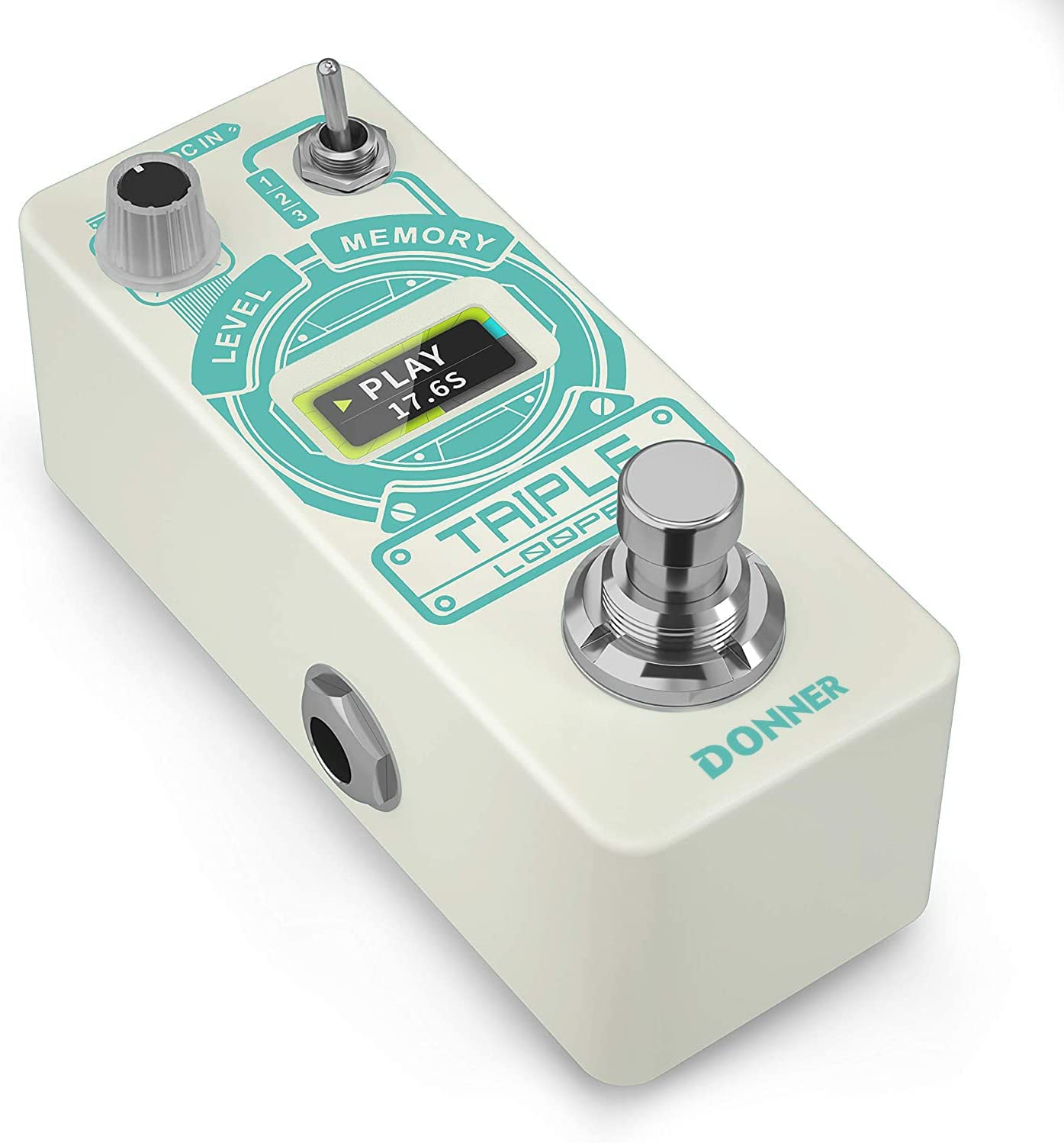
Meet the Donner Triple Looper, an excellent tool for guitarists looking to expand their sonic capabilities.
Imagine a guitar pedal that displays your looping status in real-time.
This pedal has a bright screen that tells you where you’re in your loop, letting you concentrate on your performance.
Moreover, it boasts three save slots, each capable of storing a special half-hour of loop tracks.
This versatile gadget makes your looping process easier via a single-foot switch that controls everything from recording and playing to overdubbing, stopping, and clearing.
To top it all off, it features true bypass technology that ensures a pristine, noise-free tone by keeping the electronics out of your signal path.
This white-colored pedal from Donner is compact and lightweight, weighing only 270 grams and measuring 4.72 x 2.36 x 2.36 inches.
However, remember that it doesn’t come with a power adapter, so purchase one separately.
Equipped with an advanced chip, the Donner Triple Looper retains your recorded files even after powering off.
Regarding connectivity, it uses a 1/4” jack cable for your instrument and amplifier or other effects.
From an acclaimed brand committed to innovative musical experiences, this guitar pedal offers great value and versatility.
- My Review
Fiddling around with the Donner Triple Looper, it’s hard not to be impressed.
This nifty little gadget, small but mighty like a mouse with the heart of a lion, truly packs a punch.
With its unique real-time display feature, keeping track of the looping status became a breeze.
It felt like having a roadmap for the rhythm, a real game-changer in looping pedals.
Being able to store three loops simultaneously, each up to 30 minutes long, felt like being given the keys to a musical sandbox.
The sheer creativity this enabled, akin to having a blank canvas with a rainbow of colors at your disposal, was honestly quite breathtaking.
Operating this pedal was a walk in the park.
It felt intuitive and hassle-free, with just a one-foot switch controlling the main functions.
Like a faithful hound, it responded to each press promptly and accurately, proving to be an incredibly reliable piece of gear.
One gripe I had was the absence of a power adapter in the package.
It felt like being handed a new toy only to find out the batteries weren’t included.
Buying it separately might be a minor inconvenience, but it’s an inconvenience nonetheless.
Regarding sound quality, the true bypass technology lived up to its promise.
The signal ran through a new mountain stream, clean, sober, and free of unwanted noise.
Lastly, the high-quality chip ensuring the preservation of loop tracks even after a power off was like a safety net for my creative experiments.
Here are the ratings I’ll give to the Donner Triple Looper Guitar Pedal:
The Donner Triple Looper was like a trusted sidekick, elevating my guitar playing without overshadowing it.
A brilliant blend of innovation and usability raises the bar for guitar pedals.
- Pros:
- Compact and versatile design
- Ability to record and store multiple loops
- Intuitive and user-friendly interface
- Built-in drum patterns for practice
- Cons:
- Potential audio quality degradation
- Limited storage capacity for loops
- No dedicated footswitch for stopping loops
- May require external power supply
My final verdict is that the Donner Triple Looper Guitar Pedal is a highly versatile and feature-rich pedal with excellent performance and tone.
A reputable brand backs it and provides great value for the price.
Whether you’re a beginner or an experienced guitarist, this pedal is worth considering for its impressive capabilities and user-friendly design.
FLAMMA FS21 Drum Machine Looper Pedal
Looper Pedal, Stereo Guitar Pedal, 160mins Recording, 100 Drum Grooves.
FS21 Drum Loop Pedal is a switchable two-module looper and rhythm pedal that features an external footswitch control, merger control, USB connection, and editor software. It is designed to help musicians of all levels easily create, practice, and perform music. Flamma products provide an affordable and convenient way to access the latest music technology.
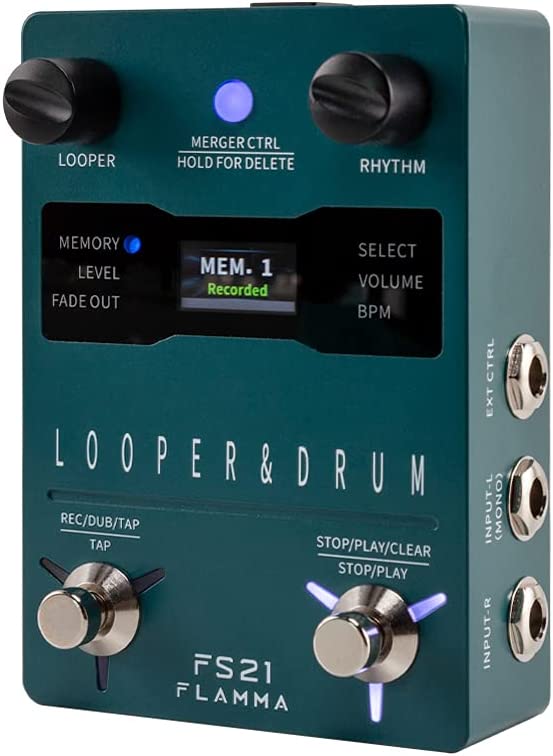
You’ll find impressive sound quality that sets it apart at the heart of the compact and stylish FLAMMA FS21 Drum Machine Looper Pedal.
Sporting a 44.1kHz 24bit audio resolution, this device delivers pristine audio, similar to high-end professional studio equipment.
Generously, it allows up to 4 minutes of recording per track, amassing 160 minutes of recording capacity.
One of the device’s most compelling features is its ability to cycle through 100 drum grooves across ten styles.
This means you can immerse yourself in a variety of musical experiences.
For rhythm guidance, the pedal provides a range of metronome settings.
Navigating between foot switches, however, might require some familiarization.
Further enhancing its functionality, the FS21 includes an EXT CTRL function, although an external footswitch isn’t part of the package.
Lastly, managing your recordings efficiently supports connection to a computer for import and export functionality.
Just bear in mind that Mac M1 chip users might encounter compatibility issues.
- My Review
Looking at the FLAMMA FS21 Drum Machine Looper Pedal immediately hits you with its compact and sleek design.
It’s an intuitive little device, offering high-quality sound at 44.1kHz 24bit, a feature that shines like a diamond in a coal mine.
Additionally, with each track offering up to 4 minutes of recording time, it’s quite a beast for memory – you get a whopping 160 minutes total!
Navigating through 100 drum grooves across ten unique styles feels like an adventurous trek across diverse musical landscapes.
You’re given a range of metronome settings, making it a drummer’s delight in a tiny package.
A word to the wise, though – there’s a bit of a learning curve when switching between the foot switches.
There’s also an EXT CTRL function, a wonderful add-on, but remember, the external footswitch is not included in the package and must be bought separately.
However, by plugging it in and connecting it to a computer, you can import/export your recordings, a handy feature that makes you feel like the captain of your musical journey.
One hiccup on this trip – the software isn’t compatible with the Mac’s M1 chip.
So, this might feel like a missed high note for Mac users.
And if you’re playing live, remember there’s a slight delay at the start, so sync your rhythm accordingly.
Despite a few quirks, I’ve found that the FLAMMA FS21 brings a symphony of features to the table, making it quite the lovable maestro for any aspiring or professional musician.
Here are the ratings I’ll give to the FLAMMA FS21 Drum Machine Looper Pedal:
It’s robust, feature-packed, and provides ample room for creativity, like a canvas waiting for a painter’s touch.
It could very well be the unsung hero in your musical journey.
- Pros:
- High-quality looper and drum machine
- Ample recording time and capacity
- Supports software editing and external footswitch control
- Easy to use and compact
- Cons:
- Issues with recording BPM for individual tracks
- Possible delay when starting rhythm with live performance
- Limitations in drum patterns and editing capabilities
- Compatibility issues with Mac and software downloads
My final verdict is that the FLAMMA FS21 Drum Machine Looper Pedal is a feature-rich and versatile pedal that offers high-quality performance and a range of drum grooves.
While it may have some limitations regarding recording BPM and compatibility with Mac, it provides value for money with its affordable price and solid construction.
It is right for musicians looking for a compact and easy-to-use looper pedal with drum machine capabilities.
What exactly is a looper pedal?
A looper pedal, also known as a looping station or loop station, is a piece of musical hardware that records, stores, and plays back audio segments in a continuous loop.
This device has gained considerable popularity among musicians, particularly guitarists, for its ability to create layers of sound that add depth, complexity, and versatility to a solo performance.
The looper pedal can be considered a “live recording” device.

When activated, it starts recording the sound input from an instrument, such as a guitar or a microphone.
Once the musician has finished playing a phrase, riff, or chord progression, they can stop the recording process, and the looper pedal will automatically begin playing back the recorded segment in a continuous loop.
The musician can then layer additional sounds over this original loop, creating complex and layered musical compositions.
One of the key features of a looper pedal is its capacity for overdubbing.
Overdubbing refers to recording additional audio while listening to the playback of previously recorded audio.
In the context of a looper pedal, this enables a musician to layer sound upon sound, creating intricate musical structures in a live performance setting.
This function is particularly useful for solo musicians, who can use the looper pedal to simulate the sound of an entire band.
Looper pedals often come with additional features and controls, such as the ability to independently control each layer’s volume, undo and redo functions, store and recall loops, and even built-in effects.
They can also have multiple footswitches for different controls, such as recording, playback, overdub, stop, and clear.
Some higher-end models also have more advanced features, like the ability to change the speed or pitch of the playback, simulate backward playback, and more.
Looper pedals can be used in various ways in a musical setting.
For instance, they can be employed to create complex solo performances, practice improvisation over chord progressions, develop song ideas, or even as a tool for practicing timing and rhythm.
Moreover, despite their wide use with guitarists, they can be used with almost any instrument plugged into them, including bass, keyboards, and even microphones for vocals or percussion.
Musicians often exploit the potential of the looper pedal for live performances to add a unique dynamic to their music, simultaneously engaging the audience as they construct and deconstruct their sonic creations.
Artists like Ed Sheeran, KT Tunstall, and Tash Sultana have become well-known for using looper pedals in their performances.
However, using a looper pedal demands precision and musical aptitude.
Timing is crucial when using a looper pedal; the musician must start and stop the loop at the exact moment to ensure the loop does not sound disjointed.
Furthermore, any mistakes made while recording a loop or overdub will be repeated every time the loop plays back.
Hence, it requires high precision, practice, and skill.
What should you consider when choosing a looper pedal?
Choosing the right looper pedal for your needs is essential to create the desired layered soundscapes and performances.
There are several factors to consider when making your decision.
This includes sound quality, controls and features, analog vs. digital, build quality and durability, presets and versatility, brand reputation, price and budget, and reviews and recommendations.
– Sound quality
Sound quality is an important consideration when choosing a looper pedal.
The sound quality produced by the pedal should closely match the original recording or performance, which will help with looping and live performances.
Consider the quality of the audio and whether it is noisy, muddy, or clear and clean.
High-quality components and circuitry will provide better sound quality and a more enjoyable experience.
It’s also useful to consider the audio formats the pedal supports, such as lossless WAV or MP3.
– Controls and features
The controls and features of a looper pedal are another vital factors to consider.
Look for pedals with intuitive controls and straightforward interfaces that are easy to use.
Some pedals offer greater customization options, such as loop decay, loop speed, and global effects, whereas others have simpler designs with fewer features.
For those new to looping, a pedal with a minimal number of controls may be a suitable choice, as it can help prevent becoming overwhelmed by components.
However, more advanced users may prefer versatile features and the ability to adjust parameters on the fly.
– Analog vs. Digital
Analog and digital loop pedals also have differences that may dictate which type suits you better.
For example, analog loopers offer warmer, more natural tones that appeal to some musicians, whereas digital loopers have clearer, sharper sound quality.
Analog pedals, however, may have shorter loop times and fewer options for customization, while digital pedals can offer longer loop times and more features.
The choice ultimately depends on your preference and how important these factors are to your music goals.
– Build quality and durability
Build quality and durability are essential when purchasing a looper pedal, especially for those who perform live or travel with their equipment.
High-quality materials and construction ensure that your pedal can withstand the test of time, endure wear and tear, and protect against damage from accidents or drops.
Prioritize pedals with a sturdy casing and reliable connections to ensure longevity.
– Presets and versatility
Presets and versatility also play a significant role in selecting the right looper pedal.
Loop pedals with presets save time by storing pre-determined settings that can be quickly accessed during performances, whereas pedals without presets require the settings to be adjusted manually.
The versatility of pedals with multiple effects and features allows for a wide range of musical options, ensuring that your pedal is useful for various applications.
– Brand reputation
Brand reputation may also factor into your decision, as established companies with a history of producing high-quality products are often desirable.
Purchasing from reputable manufacturers means you can trust in the durability and performance of your pedal.
Some well-known brands to consider when looking for a looper pedal include Boss, TC Electronic, and Electro-Harmonix.
– Price and budget
Price and budget considerations are crucial when purchasing a loop pedal.
First, determine your spending limit and shop for models with the necessary features within your price range.
Remember that more expensive pedals typically offer more functionality and better sound quality, but more affordable models with fewer features can still provide excellent results.
– Reviews and recommendations
Finally, reviews and recommendations are valuable when making your looper pedal decision.
Research online reviews from fellow musicians, professional gear websites, and more to ascertain the pros and cons of the pedals you are considering.
Asking friends or acquaintances with similar gear preferences can provide helpful recommendations and insights.
How to properly use a looper pedal?
In the world of music, a looper pedal is a powerful tool that enables musicians to create intricate soundscapes, layer melodies, and even simulate the sound of a full band, all with a single instrument.
Mastering the art of the looper pedal can significantly enhance your live performances, broaden your creative horizons, and add a whole new dimension to your music.
But how do you properly use a looper pedal? This next section will walk you through the most essential steps:
– Familiarize yourself with the controls and features:
The first step to properly using a looper pedal is understanding its controls and features.
Most pedals have standard controls such as record, play, overdub, stop, undo/redo, and clear.
The record button initiates the capturing of the sound, overdub allows you to add layers on top of the original loop, stop ends the playback, undo/redo lets you manage mistakes, and clear deletes the entire loop.
Other advanced features like volume control for each layer, built-in effects, or the ability to change the speed or pitch of the playback may be available in more sophisticated models.
Reading the user manual and watching tutorial videos can be beneficial in getting acquainted with your specific model.
– Adjust the parameters to suit your musical goals:
Once you understand the basic controls, you can adjust the pedal’s parameters to suit your musical goals.
This includes adjusting the volume levels of the loop and overdub, the playback speed, and any effects your looper pedal may have.
First, consider what you’re trying to achieve with your loop pedal.
Are you looking to create a simple backing track to play over, or are you aiming to construct a multi-layered soundscape?
The answer to this question will guide your parameter settings.
– Incorporate the loop pedal into your signal chain:
Incorporating the loop pedal into your signal chain is the next step.
The signal chain is the sequence of effects units your instrument passes through.
It’s typically recommended to place the looper pedal at the end of your signal chain.
This setup ensures that all the effects applied to your instrument’s signal will be captured in the loop.
– Practice starting and stopping the loop with precision:
One of the trickier aspects of using a looper pedal is the timing of starting and stopping the loop.
To ensure a seamless loop, it’s crucial to press the record button when you start playing and press it again right when you finish the phrase.
Perfecting this timing may take some practice, but the result is worth the effort.
Again, you can practice with a metronome or drum track to help develop this skill.
– Gradually layer multiple loops to create complex soundscapes:
You can start layering multiple loops as you get more comfortable with your looper pedal.
Start with a basic rhythm or chord progression and gradually add layers like melodies, harmonies, or percussion sounds.
Remember, the most compelling loops often come from simplicity.
It’s easy to create a cluttered sound by adding too many elements.
Practice and experiment to find the right balance.
– Manage loop volume and balance during live performances:
Managing loop volume and balance is crucial when using a looper pedal in a live setting.
An unbalanced loop, where one element overwhelms the others, can detract from the overall performance.
Some looper pedals allow independent volume control for each layer, enabling you to keep everything balanced.
It’s also essential to monitor the overall loop volume against any live playing you’re doing on top of the loops.
– Experiment with different loop textures and effects:
Lastly, don’t be afraid to experiment with your looper pedal.
Try different textures by using various instruments or techniques.
Use the built-in effects if your looper pedal has them, or use external effects pedals to alter the sound of your loops.
Reverse playback, half-speed, and pitch-shifting are just a few effects you could incorporate.
How to order pedals on a pedalboard?
There is no one-size-fits-all approach to ordering pedals on a pedalboard, as the optimal arrangement largely depends on the specific sound you’re aiming for.
Usually, though, you will see guitar players mostly agreeing with this order:
Tuner > Filters/Dynamics > Pitch-based Effects > Overdrive/Distortion > Modulation > Time-based Effects > Looper
Aside from that, some general guidelines can help you achieve a balanced and versatile setup.
Let’s talk in detail about the order we just mentioned, but feel free to experiment and adjust to your own preferences:
- Tuner: Place your tuner pedal first to ensure your signal is in tune before passing through the other pedals.
- Filters and dynamics: Wah-wah, envelope filters, compressors, EQs, and noise gates should come next. These pedals affect your sound’s dynamic and tonal aspects, so it’s best to place them early in the chain.
- Pitch-based effects: Octavers, harmonizers, and pitch shifters should come after filters and dynamics since these pedals alter the pitch of your signal and work best with a clean, unprocessed sound.
- Overdrive and distortion: Overdrive, distortion, and fuzz pedals typically come next. They shape your guitar’s core sound, and placing them before most other effects ensures that those effects receive a strong, consistent signal.
- Modulation effects: Chorus, flanger, phaser, and tremolo pedals should be placed after overdrive and distortion effects. We do this to allow these pedals to add depth and movement to your sound without becoming overly distorted or overbearing.
- Time-based effects: Delay and reverb pedals should be placed towards the end of your signal chain. This allows them to create a sense of space and depth around the other effects, simulating the sound of a room or hall.
- Looper: If you use a looper pedal, it should be placed last in the chain. This ensures that you’re looping the entire signal, including all the effects you’ve applied.
Remember, these are just general guidelines and what generally works and sounds good.
The most important thing is to experiment and find the arrangement that best suits your personal sound and style.
For example, here’s one pedalboard signal chain that I always use:
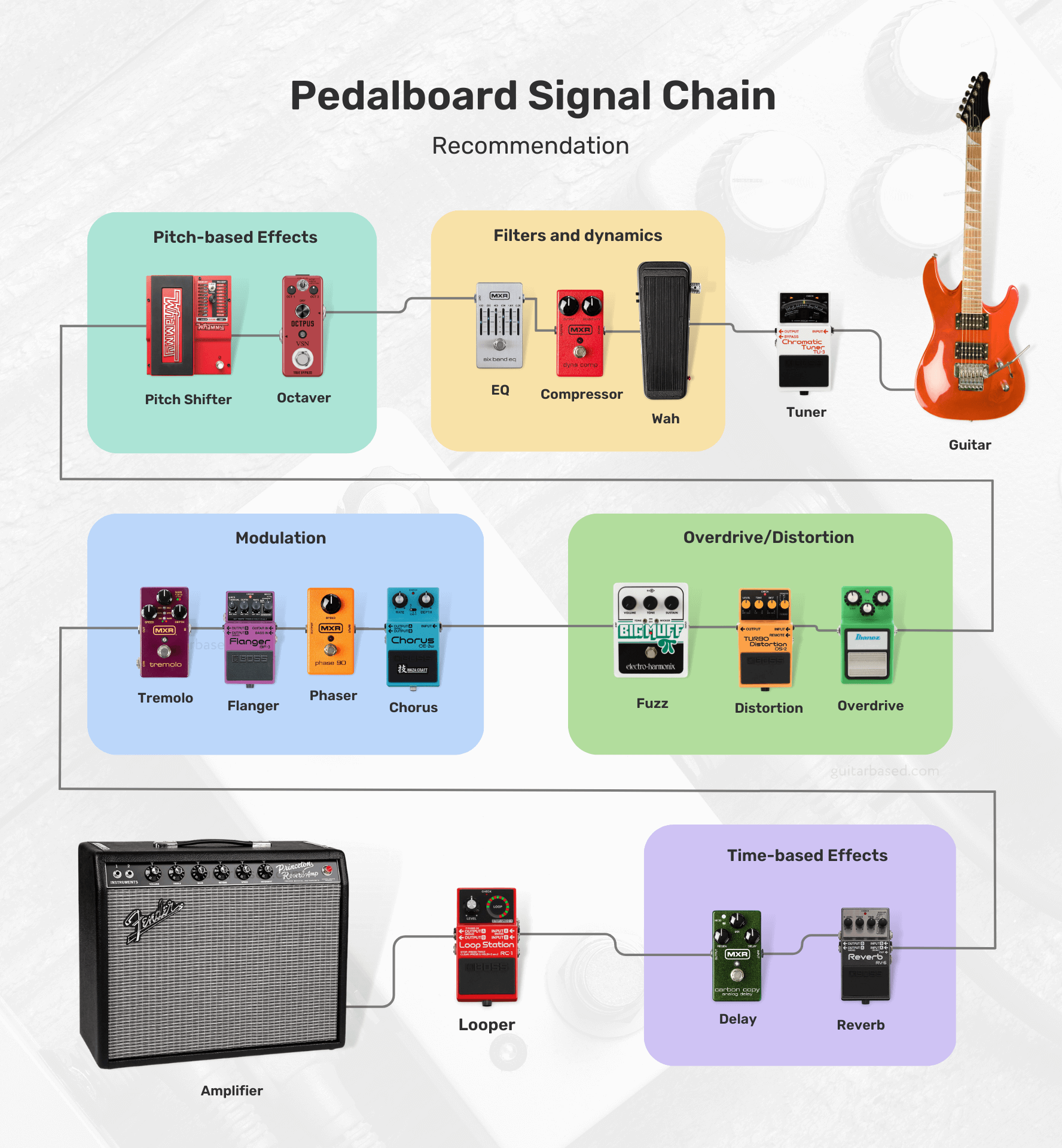
Feel free to swap the order of pedals, try different combinations, and test out unconventional setups until you find the one that works best for you.
For those interested, I’ll leave you with most of the possibilities that you’ll encounter and how to order them.
- Tuner
- Filters/Dynamics:
- Volume
- Wah
- Auto-Wah
- Compressor
- Noise Gate
- EQ (Equalizer)
- Pitch-based Effects:
- Octaver
- Harmonizer
- Pitch Shifter
- Overdrive/Distortion/Fuzz:
- Boost
- Overdrive
- Distortion
- Fuzz
- Modulation:
- Chorus
- Phaser
- Flanger
- Univibe
- Vibrato
- Tremolo
- Time-based Effects:
- Delay
- Echo
- Reverb
- Synth/Bitcrusher:
- Synth
- Bitcrusher
- Acoustic Simulator
- Multi-Effects
- Utility:
- Buffer
- A/B/Y Switcher
- MIDI Controllers
- Looper
Boutique vs. Mass-Produced pedals
Boutique pedals are generally built with higher-quality components and craftsmanship, resulting in better durability and longevity.
These pedals often feature unique and innovative designs, providing a wider range of tones and effects that may not be available in mass-produced options.
Here are a few examples of boutique pedals:

All the manufacturers also tend to have a more personal approach, with better customer service and the ability to customize pedals according to the user’s preferences.
However, boutique pedals are usually more expensive due to the smaller scale of production and the use of premium components.
Mass-produced pedals, on the other hand, are more affordable due to their larger scale of production and the use of cost-effective components.
These pedals are widely available and offer a range of popular effects, making them accessible to a larger audience.
Here are a few examples of mass-produced pedals:

The quality control for mass-produced pedals can vary depending on the brand and model, but many are reliable and offer good value for the money.
As for one of the downsides, you’ll find that mass-produced pedals may not have the same level of uniqueness or innovation as boutique options.
On the other hand, they may not provide the same level of customer service or customization options.
The choice between boutique and mass-produced pedals depends on your personal preferences, budget, and desired sound.
If you’re looking for unique tones, higher-quality components, and a more personal experience, boutique pedals may be the way to go.
But I would say, for those who are on a budget and need access to popular effects, mass-produced pedals might be a better fit.
It’s worth trying out both types to see which best suits your needs and playing style.
How much should you spend on a guitar pedal?
If I were in your position, I would first determine my budget and specific needs before deciding how much to spend on a guitar pedal.
For beginners, it might be more reasonable to start with affordable, mass-produced pedals to explore different effects without spending too much.
Guitar pedals can range in price from around $30 to over $400, depending on the brand, quality, and complexity of the effect.
As your skills and understanding of your preferred tone develop, you can gradually upgrade to higher-quality or boutique pedals.
One thing I would do is consider which effects are essential to your playing style and prioritize purchasing those first.
Allocating a larger portion of your budget to the most important pedals might be a wise choice, especially if you only need a few basic effects.
However, if you require a wide array of effects, you may want to consider more budget-friendly options or multi-effects units.
Keep in mind that higher-priced pedals often come with better build quality, unique features, and improved sound quality.
But I would also say that price is not always directly correlated with quality or suitability for your needs.
Sometimes, a more affordable pedal can deliver the exact sound you’re looking for, while a higher-priced option might not meet your expectations and are only expensive because of the brand reputation.
Can you use a guitar pedal with a bass guitar?
You can certainly use a guitar pedal with a bass guitar.
But it’s crucial to be aware that some guitar pedals may not be specifically designed to accommodate the frequency range of a bass guitar.
This could result in a less-than-ideal performance or an altered tone that might not be what you were expecting.
If you’re feeling adventurous and eager to experiment with your sound, don’t hesitate to connect your guitar pedals to your bass guitar.
This can be a fun way to explore different sonic possibilities, and you might even stumble upon some unique tones that complement your playing style perfectly.
Using a guitar pedal with a bass guitar may not always produce the desired results.
In some cases, the low-end frequencies might be lost, or the effect could sound too harsh or muddy.
To avoid these issues, you could consider looking into pedals that are specifically designed for bass guitars.
These pedals are engineered with the bass frequency range in mind, ensuring that your low-end remains intact and the effect sounds as intended.
In addition to bass-specific pedals, there are also multi-effects processors and pedals that cater to both guitar and bass players, offering a wide range of effects and tonal options.
These versatile units can be a great solution if you play both instruments and want a single device to cover your needs.
How to properly power your pedals?
When it comes to powering your pedals, you want to make sure you’re doing it right to avoid any noise issues or potential damage.
First, check each pedal’s power requirements, which you can usually find in the manual or on the pedal itself.
You’ll want to pay attention to the voltage (usually 9V, 12V, or 18V) and current (measured in milliamps or mA).
Now, you’ve got a few options for powering your pedals.
You can use individual power supplies or batteries for each pedal, but that can get messy and inconvenient.
I’d recommend going for a pedal power supply or an isolated power brick.

For example here are a few ones I recommend:
- Voodoo Lab Pedal Power 2 Plus Isolated Power Supply (My favorite)
- Rowin PW-1 Guitar Pedal Power Supply (Cheapest)
These babies can power multiple pedals at once, and the isolated outputs help prevent noise and ground loop issues.
Just make sure the power supply you choose can handle the voltage and current requirements of all your pedals.
When you’re connecting everything, use good quality power cables and keep them neat and tidy to avoid a tangled mess.
You might even want to use cable ties or cable organizers to keep everything in order.
In love with guitars, and gear; expert in all things music! Been writing about guitars for about 5 years and counting. Born in the ’90s. Alma Mater: University of Havana. Always curious, trying to understand the world. #TeamFender

